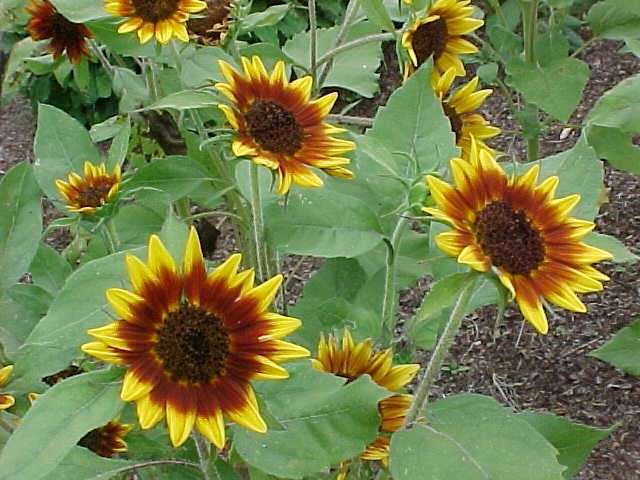 |
Helianthus annuus
sunflower
Annual
Well, I’m not going to write an article on annuals… so I thought I’d throw this fun flower into the perennial article. That’s semi-legit because they do come up in a lot of gardens every year. Now that I’m completely justified….let me say, Sunflowers are LOTS OF FUN! They are the ideal plant to begin teaching children with… they grow fast enough to fascinate both student and teacher. And the flowers are big enough to fascinate you all over again. These days they come in an enormous range of colors and sizes… so please yourself, but make sure you have at least 1-3 giant sunflowers so the kid’s can learn about feeding birds and about salted sunflower seeds. There is always just enough sun in any garden for a small patch of these prairie loving flower giants. |
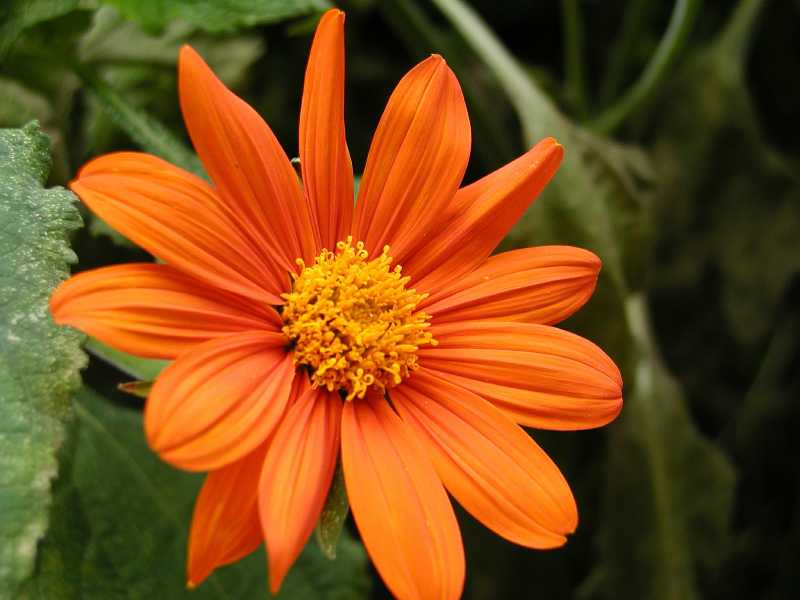 |
Tithonia rotundifolia
Mexican sunflower
Annual
Forgive me, I’m going to add one last plant that really belongs elsewhere. I try and grow it every summer, so it seems like a perennial to me. This is another great plant to use teaching kids about plants & gardens. Grow it from seed. Get the old fashioned standard… not the newer dwarf varieties. Go for broke…. The older, bigger one is far more impressive. Give it about 4x4 feet to grow in, and plenty of sun. Plant 5-7 seeds in a one foot circle…..and watch those seedlings fill the whole space with heavily branched stems of corrugated dark green foliage. In late summer the “bush” will erupt with 3-4 inch, pure orange flowers that are great fun…. And attract LOTS of butterflies. Deadheading spent blooms could extend bloom into fall. |
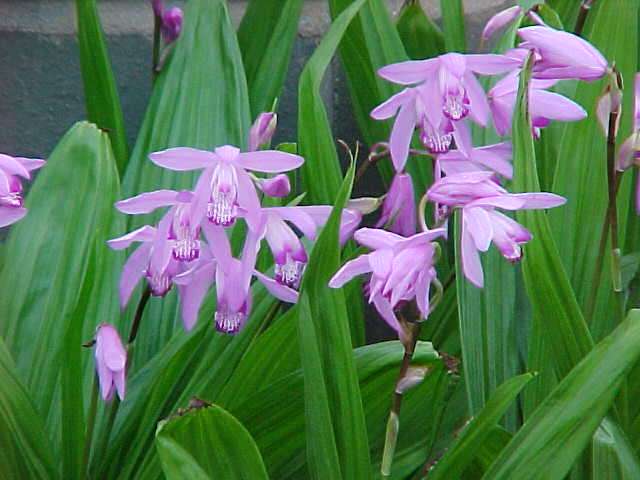 |
Bletilla striata
Chinese ground orchid
Bulb
I never paid lots of attention to this ‘orchid’ until I saw a large mass of them at the Oklahoma City Zoo. Now, I have trouble imagining a garden without them. The blooms are delicately beautiful and bold enough to stand out in the garden. This perennial is well suited to wet spots that get shade on summer afternoons. Keep the soil moist, but not waterlogged. ‘Albostriata’ is equally successful here, just harder to find. |
 |
Lilium 'Connecticut King'
Asiatic lily
Bulb
Lilies grow and bloom well in Oklahoma City gardens as long as they are given WELL-drained soil. These bulbs are markedly intolerant of wet feet. Given that, and sun to light shade, they can be a long-lived & naturalizing plant for our gardens. I will recommend you either stick with the shorter varieties or those with very strong stems. Otherwise you will want to stake lilies in Oklahoma to protect them from our winds. |
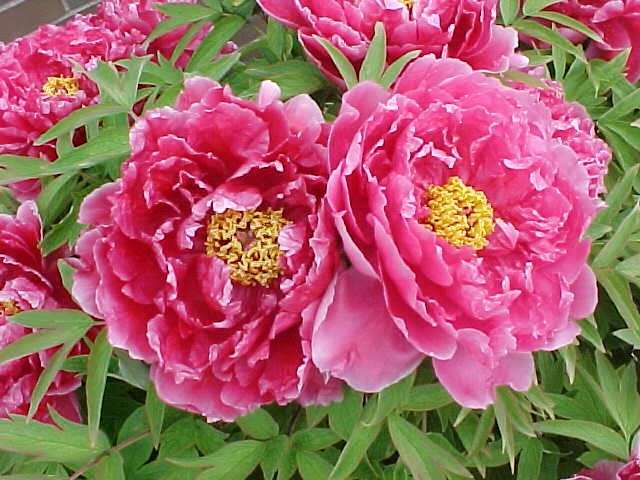 |
Paeonia suffruticosa
tree peony
Deciduous shrub
I’ve chosen to list this shrub with perennials because, in my area, perennial gardeners will be far more likely to plant them. [Just an opinion that has proven pretty well true for the past 31 years.] Tree Peonies in Oklahoma definitely benefit from shade during hot summer afternoons. They also enjoy protection from desiccating southwest summer winds. Give them well amended soil…and avoid moving them. They are slow to establish here… but they are more than well worth the wait. Named cultivars can be found on several reputable internet nurseries. Basic shades of red, pink, and white can be found container grown in local nurseries. Avoid the bare root plants that come in plastic baggies at check-out counters. Tree Peonies are very adaptable to Oklahoma growing conditions… gardens in the old ‘Heritage Hills’ portion of Oklahoma City contain Tree Peonies known to be 75-100 years of age. This is an extraordinary plant… and a beautiful mixed border should contain at least one. Pick your color carefully… it will be with you for a long time. |
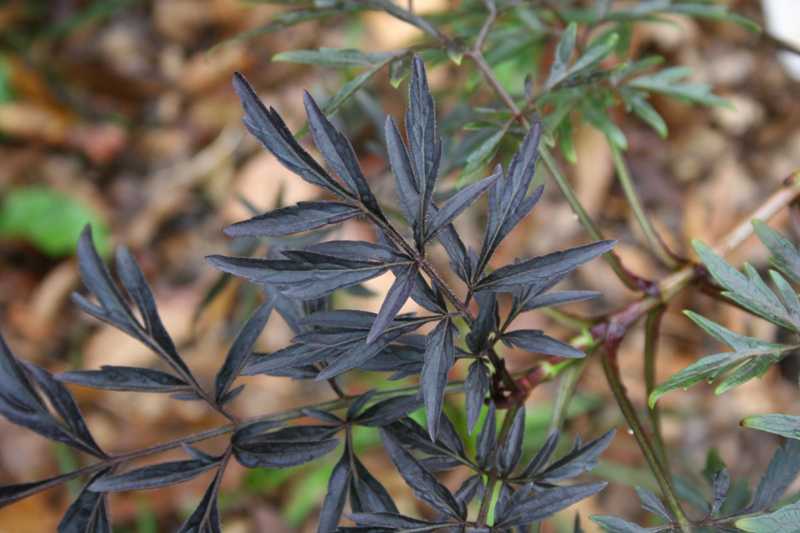 |
Sambucus nigra 'Gerda' BLACK BEAUTY
black elder
Deciduous shrub
This is a large plant for large borders or prominent locations… or both. I list it with perennials only because I saw it back to the ground each spring to control its height and spread. Controlled this way, mine get to the 6x6 foot stage… and bloom quite heavily. Although some afternoon shade is acceptable, good light is also important. And good soil that drains fairly well is also to its advantage. I linked to S. nigra ‘Gerda’ because I want to suggest ‘Madonna’ and ‘Gerda’ [Black Beauty] as noteworthy plants. The first has creamy yellow variegation on its foliage and white blooms. The second has smoky black green foliage and nice pink heads of fragrant bloom. ‘Sutherland Gold’ has all golden foliage and is also highly recommended. All do well here with a little planning and mid-summer deep watering. |
 |
Athyrium niponicum var. pictum
Japanese painted fern
Fern
This fern could easily be seen as the most popular one grown in Oklahoma gardens. The subtle shadings of color in its fronds gives it a nicely exotic “look.” It is small in stature….so consider planting it close to a viewing area. Based on numerous plantings at the OU Medical Center, I can say this fern grows quite well, and holds color, in pretty serious shade. |
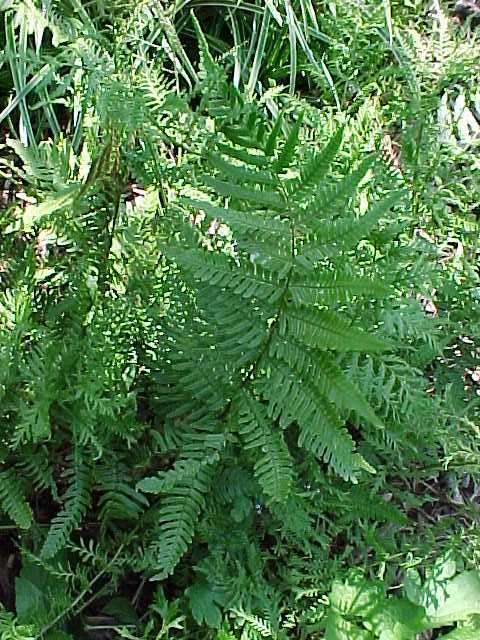 |
Dryopteris erythrosora
Japanese shield fern
Fern
Autumn Fern has proven to be an exceptionally reliable fern for Oklahoma City gardens. It does need afternoon summer shade, well amended soils, and extra water during high heat. Given those conditions it provides a lush “mound” of fronds with an excellent medium green color. The new fronds have a very attractive bronze coloration that lasts quite awhile and distinguishes this fern from many others. Mine have proven almost evergreen for several winters. I remove old fronds in spring to encourage lots of new ones. This fern looks just terrific in flower arrangements. |
 |
Polystichum polyblepharum
tassel fern
Fern
Another very hardy fern for central Oklahoma gardens. The fronds are dark green, with a somewhat leathery texture. The stalk is covered with cinnamon gold “hair”…which gives emerging fiddlenecks an exotic appearance. Evergreen in mild winters here. Remove unsightly foliage as it develops. Of the 5 ferns I grow, this one is decidedly the most striking. |
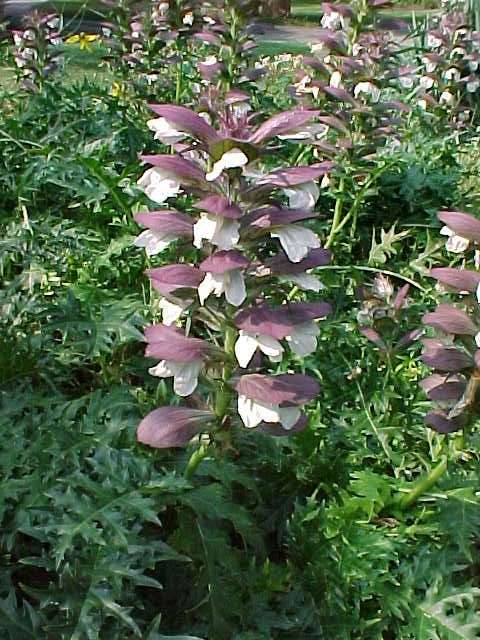 |
Acanthus spinosus
bear's breeches
Herbaceous perennial
This is a fascinating perennial for Oklahoma gardens….. but it is seldom used in them. The leaves are bold & dramatic, and stand out well in heavily planted borders. The spike of blooms is downright architectural. It is thick and strong, capable of weathering our winds without staking, and is the center of attention during its bloom span. The only downside is the fragrance of the blooms…. it isn’t called bear’s breeches for nothing! Plant it far enough away not to smell it. Give it good, organic, well-drained soils and afternoon summer shade. |
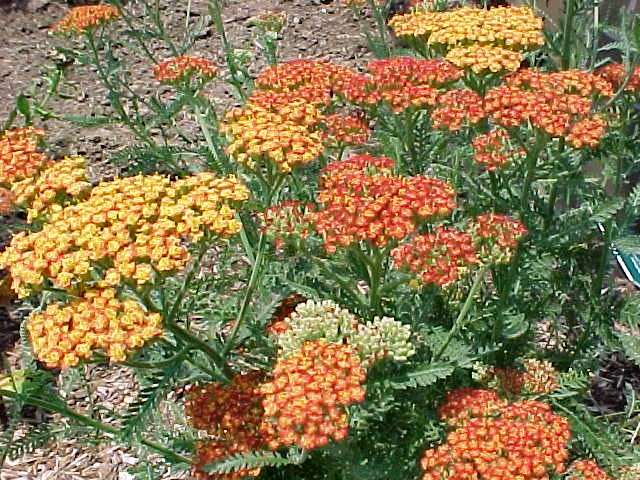 |
Achillea 'Terracotta'
yarrow
Herbaceous perennial
Yarrows love Oklahoma! And Oklahoma gardeners love Yarrow… I’ll mention this perennial with an emphasis on ‘Terracotta’ because we all too often plant only the yellow, and occasionally the red, yarrows. I’ll also suggest it by way of suggesting mixing yellows, burnt oranges, and reds in beds to both increase bloom time and offer a distinct prairie sunset look to the garden. Good drainage is even more imperative here than in Missouri….because we always assume this plant will do well in any sunny garden here. It most frequently fails because of wet roots and poorly drained soils. |
 |
Adenophora liliifolia
ladybells
Herbaceous perennial
Ladybells are dramatically beautiful flowers… and deserve more use in Oklahoma gardens. Give them organic, moist to wet, but very well-drained soils in afternoon summer shade and it will perform admirably. Pay attention to the PlantFinder comment about not moving or dividing this perennial. It does not like being disturbed once it is sited. If you have trouble finding it locally, it is widely available on-line. |
 |
Aegopodium podagraria 'Variegatum'
bishop's weed
Herbaceous perennial
I mention this groundcover because it is not the rampant spreader on the lower great plains that it is in Saint Louis. Even if it does escape the bounds you set for it, removal is a snap compared to the removal of say, monkey grass or daylilies. I recommend it for the cheerful color it lends a garden bed….and the enhancement it offers to green leaved plants. The blooms are very delicate in appearance but are noticeably prominent en masse. It will spread less enthusiastically in lean or dry soils….but will also be more susceptible to leaf burn during summer’s heat. Light shade and slightly moist soil is recommended for best performance here. |
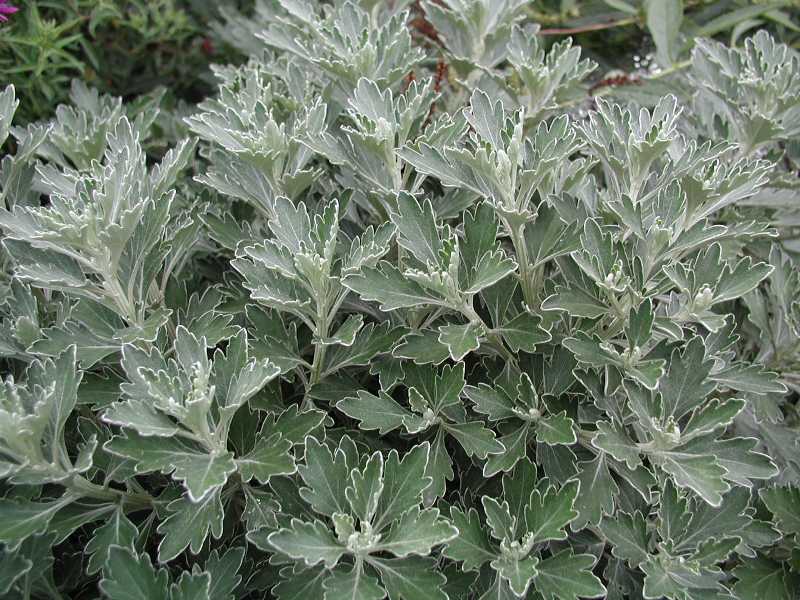 |
Ajania pacifica
ajania
Herbaceous perennial
As you can see, this is not the usual genus for mums. I can only imagine that this plant acquired it’s common name because it’s growth habit & form closely resembles chrysanthemums and because it blooms in the fall. Nonetheless, this is a terrific, low, dense “groundcover” for sunny areas. The grayish foliage edged in silver contrasts beautifully with the green foliage of other plants. The blooms are nice to have….but relatively inconspicuous. Grow this one for it’s foliage. |
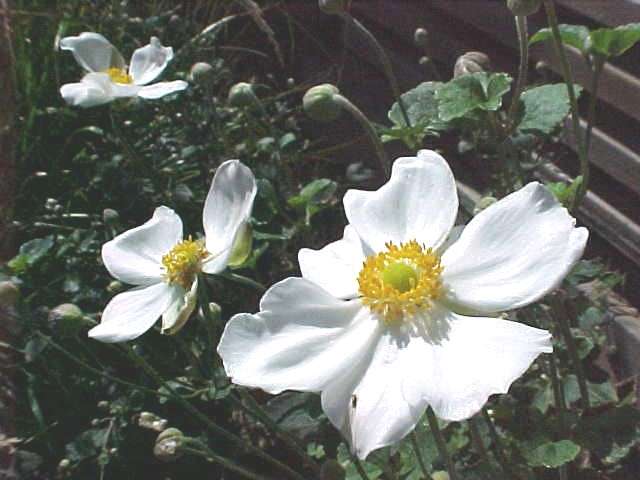 |
Anemone x hybrida 'Honorine Jobert'
windflower
Herbaceous perennial
Pay careful attention to the cultural notes on PlantFinder if you want to grow Japanese Anemones in Oklahoma. Providing those considerations will reward you with thoroughly unique blooms in late summer and early fall. I say “unique” because Japanese Anemones could and should be planted more frequently in our gardens. Their beauty is delicate, alluring and, once established very commanding. Peony cages are an excellent, and unobtrusive, way to stake this fine plant. Oh, and be patient… because these are slow to establish. |
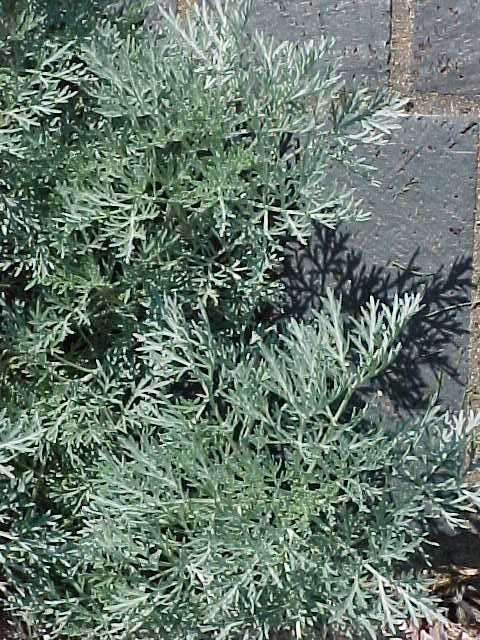 |
Artemisia 'Powis Castle'
wormwood
Herbaceous perennial
In a perennial border or mixed border, foliage is just as important as bloom…..because the foliage has season long interest and the blooms come and go. ‘Powis Castle’ Artemisia is invaluable in this regard. The silver-pewter color of it’s foliage compliments any green leaves or bloom colors close by. A well-drained site is essential, as is full sun. Because Oklahoma has a longer growing season than Saint Louis, you can expect a larger plant than described in PlantFinder. One suggestion: this plant is a superb companion plant for roses. |
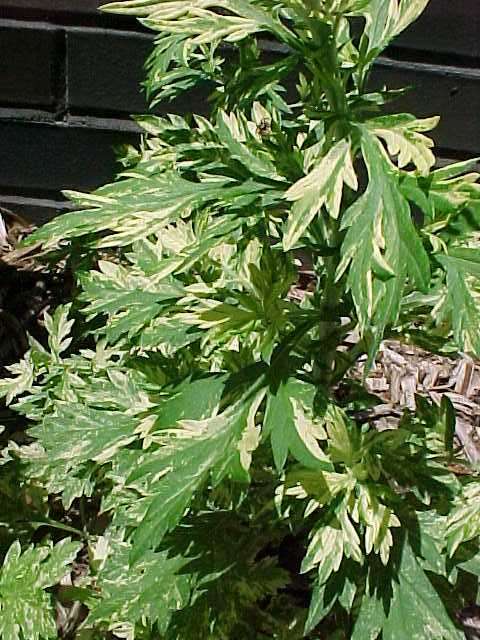 |
Artemisia vulgaris 'Janlim' ORIENTAL LIMELIGHT
wormwood
Herbaceous perennial
I’ve been growing this perennial in light shade for the past 7 years. Most of the direct sun it gets is from 2:30pm on in the summer. It has retained it’s variegated foliage color, gotten at most 18 inches tall, and spreads at a sedate and easily managed pace. It contributes to the shade bed as a moderately tall, and nicely colorful groundcover….growing around and under hostas, ferns, bulbs, lilies, knotweed, and chrysanthemums. I cut it back if it gets tall enough to muddy the overall planting scheme. But it does not dominate the plants around it…. Rather it seems to accommodate itself to the other plants… happy to be a companion. Next year it will be growing in and among clumps of Rudbeckia fulgida ‘Goldsturm’…..in addition to the other plants already mentioned. This is a nice, low-maintenance and colorful groundcover….and deserves more use in Oklahoma gardens. It waded through our recent heat wave without a blemish. A note: planting in full sun and good soil will cause it to grow taller and spread more aggressively. Generous watering will speed it’s spread. I guess I’m suggesting lean and slightly shady conditions if you want a more manageable plant. |
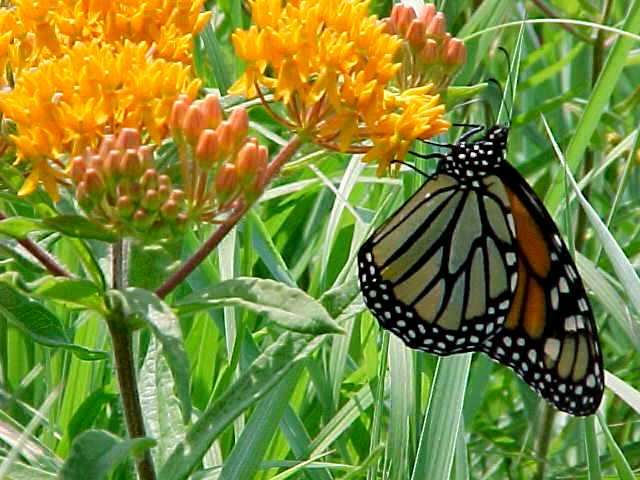 |
Asclepias tuberosa
butterfly weed
Herbaceous perennial
This is an elegant and all-too-frequently overlooked perennial Oklahoma native. I think many people avoid it or fail with it because they fail to understand how lean and dry and hot and sunny this plant likes it. Give it VERY well-drained soil in full sun, hardly ever water it, and never feed it… and it will do great for you. By all means try it….. the orange flowers are very striking and attractive…. and the plant is an absolute butterfly magnet. Your garden will be awash in flights of beauty when this perennial is in bloom. |
 |
Aster x frikartii 'Monch'
aster
Herbaceous perennial
When Oklahoma gardeners think in terms of fall bloom, we generally think “Mums!” Period. Monch Aster will open up a whole new world of fall bloom for us. The lavender blue blooms with yellow centers are a terrific alternative to mums, and I also find they are easier to grow. Many of the other species & cultivars of Aster that are listed by PlantFinder will perform quite well here. Shade on hot summer afternoons is a good idea in our area. And supplemental water will be necessary during the heat of summer. Plant asters in generously amended garden soil. Pinch the plant’s growing tips when they are about 6 inches tall. This will give you a bushier plant by fall, with many blooms. |
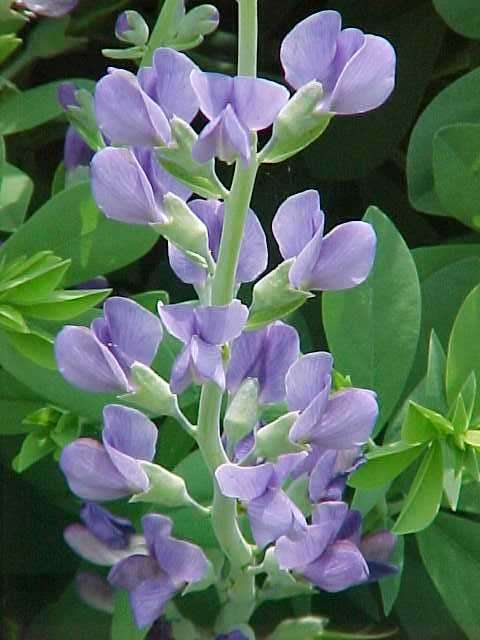 |
Baptisia australis
blue false indigo
Herbaceous perennial
It’s bloom period doesn’t last long enough to suit me [I want MORE !]….but I really enjoy the blue-gray foliage topped with racemes of the nicest blue flowers. The seedpods that follow are the same deep blue as the blooms, with a flatter finish. The seedpod stalks are great in dried arrangements. Give this perennial plenty of sun…and not overly rich soil. Water deeply but allow drying out before re-watering. This is a very good and attractive perennial for middle & back portions of sunny borders in our area. |
 |
Brunnera macrophylla 'Hadspen Cream'
Siberian bugloss
Herbaceous perennial
PlantFinder notes stipulate that brunnera: “Prefers consistently moist, organically rich soils in shady areas. Tolerant of some light morning sun, but variegated leaf edges will often scorch if foliage is exposed to direct afternoon sun.” Take this advice to heart in central Oklahoma and you can expect good success with this perennial. The foliage is handsomely variegated, and the flowers are just plain delightful. The flower’s common name is perfectly appropriate: ‘Forget Me Nots.’ |
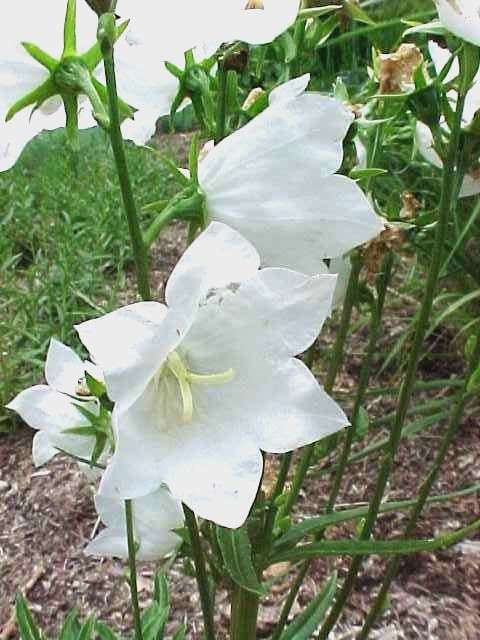 |
Campanula persicifolia 'Chettle Charm'
peach-leaved bellflower
Herbaceous perennial
This species, and it’s cultivars, have a commanding presence in any garden in which they are planted. The stems grow to 3 feet in central Oklahoma and the blooms are large and showy. A large and established planting in Oklahoma City’s Myriad Gardens attests to it’s hardiness in our area. The strong stems don’t seem to need staking… though protection from stiff southwest winds is recommended. I definitely suggest some afternoon summer shade for best results. Water consistently through the heat of summer… it fades fast if allowed to run too dry. All four of the cultivars listed in PlantFinder should do well in Oklahoma gardens. |
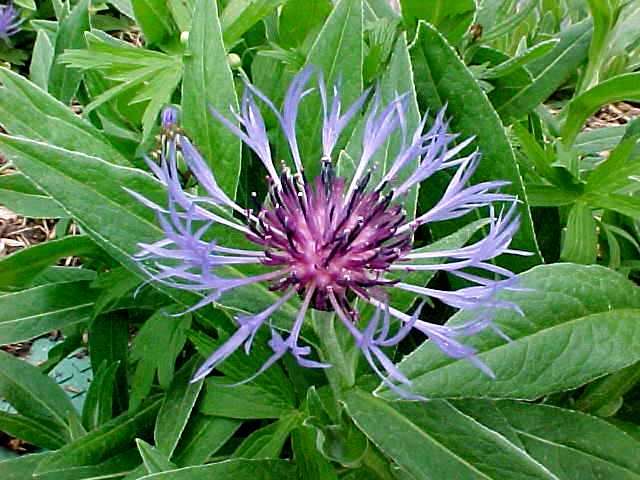 |
Centaurea montana
mountain bluet
Herbaceous perennial
Oklahoma gardeners normally call the native version of this flower a ‘cornflower.’ The species listed here has a much larger, much more ornamental bloom. Plant them in a “hot spot” – a sunny place with lean, dry soil. They will love it there… and you will be able to appreciate them yearly. All Centaurea’s mentioned by PlantFinder should do well in our area. |
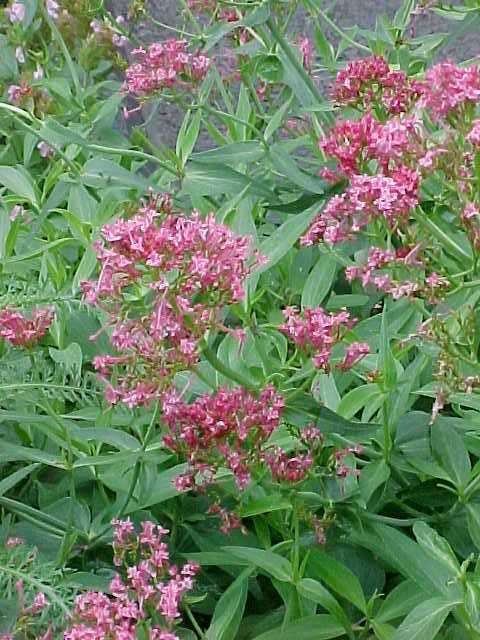 |
Centranthus ruber
red valerian
Herbaceous perennial
Although I don’t see a lot of this perennial in Oklahoma gardens, there is every reason they should succeed here. They like alkaline soils & full sun. Our leaner soils should only provide a more compact plant. This perennial has a distinct appeal… its flowers are a unusual shade of red that is very attractive…. particularly in combination with blue blooms or foliage. The white form will do equally well here. |
 |
Clematis integrifolia 'Caerulea'
solitary clematis
Herbaceous perennial
This is a “bush” form of clematis… and it is highly attractive in bloom or out. I’ll recommend some summer afternoon shade and good, rich, well-drained soil. The four-sepaled, nodding blue blooms are distinctive and beautiful. My favorite aspect of this plant is the seedhead….. a marvelously complex and delicately striking creation. They give the whole plant an ethereal look that demands… and gets…. repeated glances. |
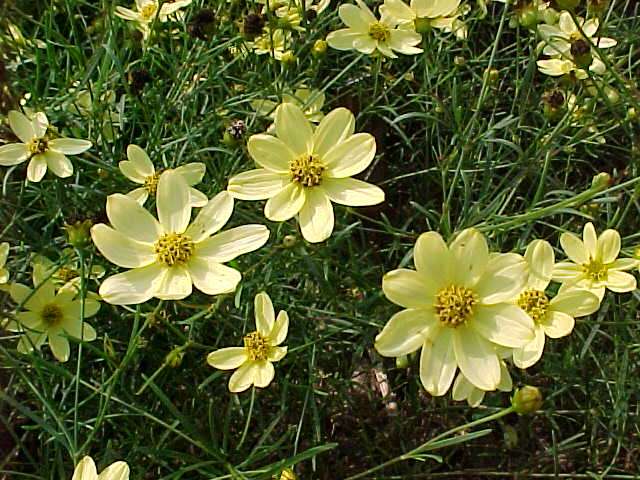 |
Coreopsis verticillata 'Moonbeam'
threadleaf coreopsis
Herbaceous perennial
I’m linking to this particular coreopsis because I like the paler yellow of its blooms. But please understand that all coreopsis are top notch performers in Oklahoma gardens. They love our hot sun and our heavy, alkaline soils. Just remember… they will appreciate being ignored more than they will appreciate good care. Most gardeners kill coreopsis by giving them too much attention. |
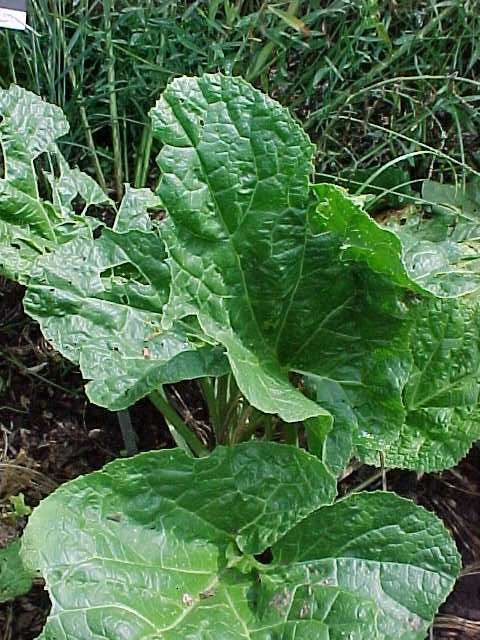 |
Crambe cordifolia
colewort
Herbaceous perennial
PlantFinder suggests this perennial will not appreciate our heat and humidity. Despite that note of caution, I have seen several very attractive specimens in Oklahoma gardens. If you choose to try this perennial, consider these suggestions. Plant in full sun only… and in soil that can easily be kept moist. Hide the foliage mound of cabbage-like leaves behind other plants. [The foliage is subject to many kinds of chewing insects and frequently looks ratty.] You are planting this perennial for its enormous “cloud” of delicate blooms. Even though they don’t last long… they will be a hot topic of conversation while in bloom. By all means, stake the flower stalk sturdily…. it is heavy and will be blown over by our winds. I wouldn’t be surprised if you’re thinking “Why in the world does this guy want me to plant this ratty looking plant!” Look at the PlantFinder image in the bottom left of the page. Imagine a bloom display roughly 10 larger than the one in the image, floating 4 to 5 feet in the air. I think you’ve answered your own question. |
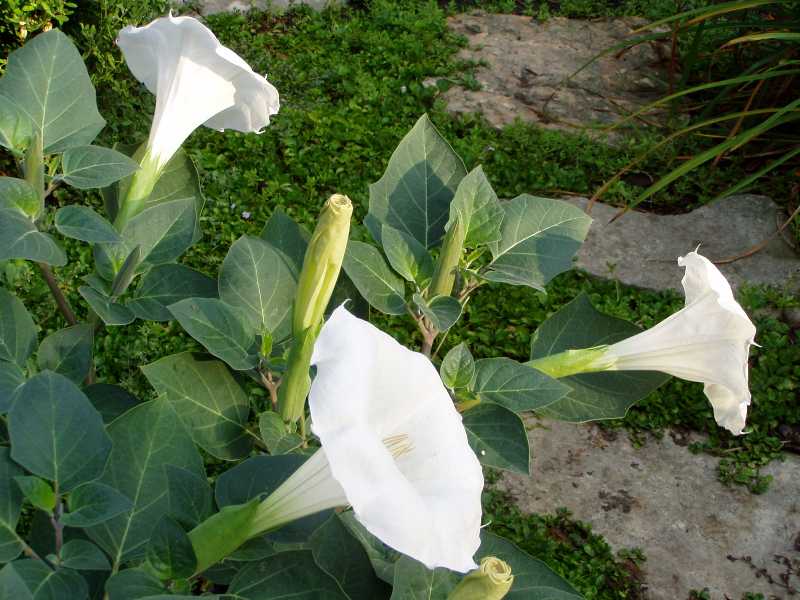 |
Datura inoxia
angel's trumpet
Herbaceous perennial
Moonflowers can get very large…so be prepared to allow them plenty of space in your sunny border. Other than sun and space they are very undemanding. Your reward is a huge number of enormous white blooms that open majestically at dusk and are gone by late the next day. The blooms have a terrific fragrance, but you might have a little trouble discerning that in Oklahoma’s windy weather. Deadhead frequently to avoid a decline in blooms caused by seed production. |
 |
Echinacea purpurea
purple coneflower
Herbaceous perennial
A wonderfully free-flowering perennial for sunny borders. Deadhead spent blooms to keep new ones coming. But let the last stems and seedheads remain in the fall…they are attractive into winter. Sunny well-drained sites are best. |
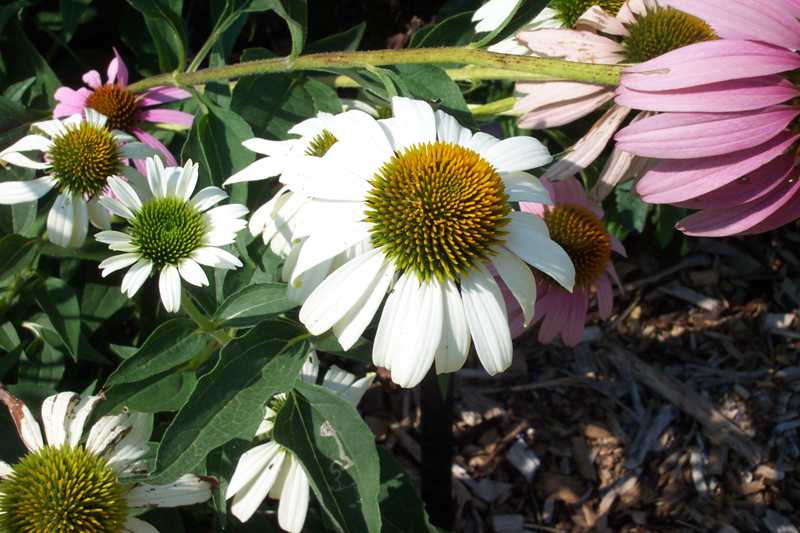 |
Echinacea purpurea 'White Swan'
purple coneflower
Herbaceous perennial
This is just the ticket for Shasta Daisy lovers. The blooms are larger….and they appear all summer long providing you deadhead. For sunny well-drained locations in the border. Try this one in combination with Russian Sage and perennial Salvias….you won’t be disappointed. |
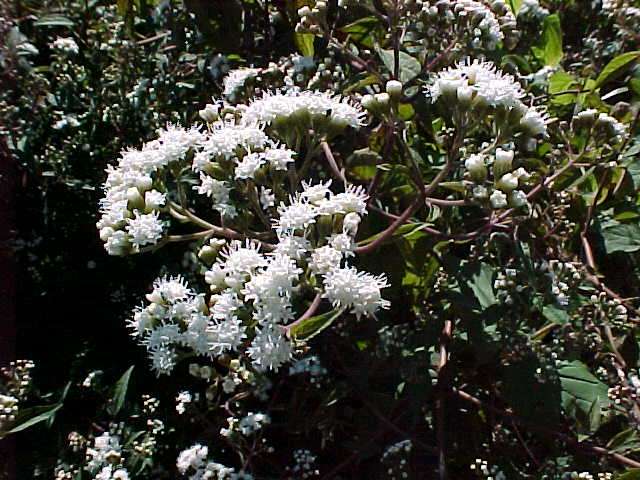 |
Eupatorium rugosum 'Chocolate'
white snakeroot
Herbaceous perennial
Plant in full sun sites with well-drained soil that can be kept moist to wet. Note the distinction… you want moist to wet without becoming waterlogged. Summer afternoon shade is desirable to a degree, but don’t overdo it. By all means, deadhead spent blooms to avoid unwanted seedlings the following year. Plants like this one and Sambucus nigra ‘Gerda’ offer us strikingly unique foliage and bloom combinations. They can be very complimentary to your garden, or they could be simply garish. Plan companion plants carefully to take advantage of these unique foliage colors. |
 |
Euphorbia characias 'Tasmanian Tiger'
spurge
Herbaceous perennial
A brand new introduction in our area…. and therefore untested. But well worth trying to grow. The foliage is beautifully variegated with clear white edges. Very well-drained soil is essential to its success. Full sun is also recommended, but it will tolerate some light shade. ‘Tasmanian Tiger’ has tremendous potential for Oklahoma gardeners. It is well worth looking for and planting. |
 |
Geranium x cantabrigiense 'Biokovo'
hardy geranium
Herbaceous perennial
This genus should not be confused with the annual bedding plant known and loved by your Grandmother. Their genus name is Pelargonium. Unlike bedding geraniums, Cranesbill species and cultivars are reliably perennial in Oklahoma. They also produce a much more subtle, yet much more beautiful, flower than the bedding plant. Site them in organically amended, well-drained soils and provide some supplemental water during summer’s high heat. Some shade on summer afternoons is also beneficial in our part of the country. ‘Biokovo’ is very nice because it’s white petals are tinged pink and the stamens are pink. It is delicate and beautiful in a wonderfully feminine way. Other cultivars I can highly recommend for Oklahomans include, but are not limited to: ‘Kashmir White’, ‘Wargrave Pink’, G. phaeum [for shady locations], ‘Johnson’s Blue’, G. sanguineum var. striatum [the dark veins on pink petals are very alluring], and a new cultivar called ‘Splish Splash’ [with lavender blue streaks on white blooms, it is both subtle and in-your-face.] This genus is strangely ignored by many Oklahoma gardeners. Perhaps it’s our love for “big” blooms…perhaps these plants just look too delicate out here on the big, bad prairie… perhaps we have tried them and failed. Here is a little encouragement to try again… Cranesbills survive and thrive here, and are well worth planting. Once you see them bloom in your garden, you will want to see them again and again. |
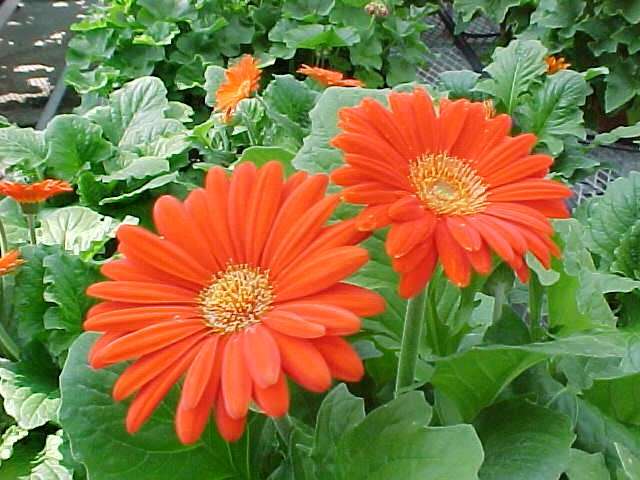 |
Gerbera jamesonii
Transvaal daisy
Herbaceous perennial
Winters are getting warmer in this part of the country and, for the time being, Gerbera Daisies seem to be perennial. Our garden has seen their return for the past five years. They seem amenable to light shade, but remember they need well-drained soil that stays lightly moist. They will rot if sited in soil that stays wet all winter…. or too wet in summer. (Perennial in Zone 7.) |
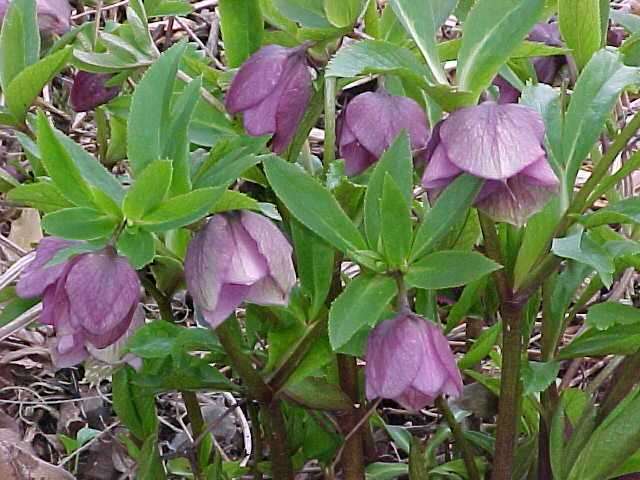 |
Helleborus orientalis
hellebore
Herbaceous perennial
The lack of Hellebores in Oklahoma gardens continues to be a mystery to me. PlantFinder says the evergreen foliage may scorch & burn in Saint Louis. In Oklahoma City gardens that rarely happens. Which leaves you with an evergreen perennial that blooms in winter. What a treat! On top of that, the blooms are singular and striking, and the foliage is too. These plants are the perfect Hosta substitute for sunnier areas, remembering that some afternoon shade is still desirable. The planting site should be vigorously amended with organic materials like peat moss and compost. Remove spent foliage after blooms decline for a new set of leaves and a fresh look for spring. |
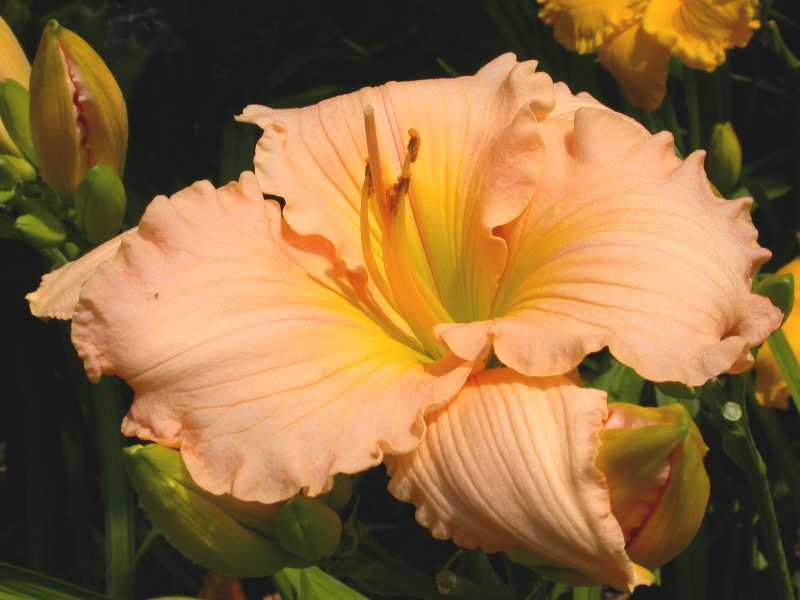 |
Hemerocallis 'Fairy Tale Pink'
daylily
Herbaceous perennial
Any Oklahoma gardener will tell you daylilies are easy to grow. I’m mentioning a specific daylily for a specific reason. Try planting this particular cultivar adjacent to Rudbeckia fulgida ‘Goldsturm’….aka Black-Eyed Susan. The combination is very striking. All daylily notes on PlantFinder apply here as easily as they do in Missouri. |
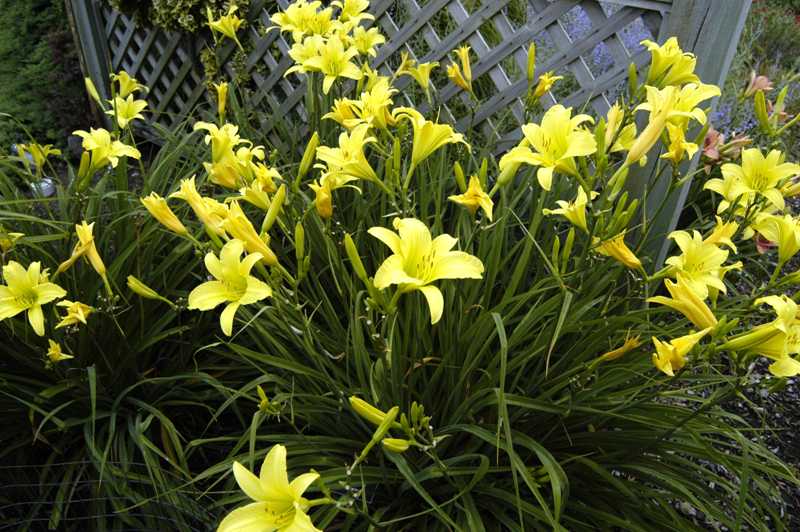 |
Hemerocallis 'Hyperion'
daylily
Herbaceous perennial
I mention this specific daylily because it’s diploid blooms are nicely fragrant. This daylily needs to be planted close to a patio or entry to appreciate the scent. Yellow blooms measuring 4 inches are nicely showy without being garish. |
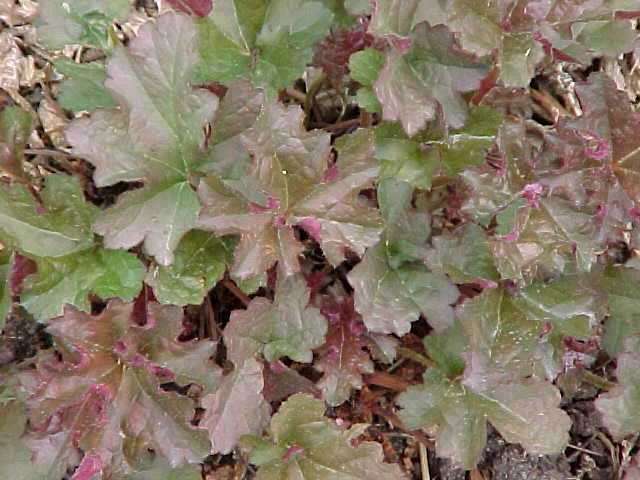 |
Heuchera 'Crimson Curls'
coral bells
Herbaceous perennial
This particular cultivar of Heuchera deserves a “very tough” rating. It waded through the 2006 heat wave with flying colors. The curled leaves maintained good coloration in my garden even though planted in fairly good shade. ‘Crimson Curls’ was purchased locally and is definitely worth a search, and subsequent planting, in your garden. |
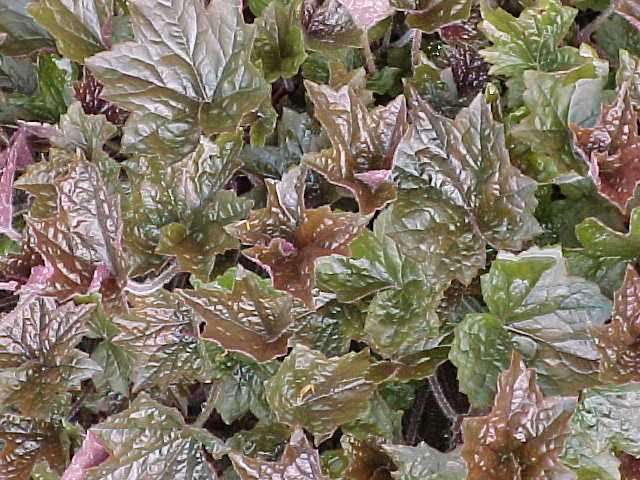 |
Heuchera micrantha var. diversifolia 'Palace Purple'
coral bells
Herbaceous perennial
Another excellent Coral Bells for our gardens…even though the name is bigger than the plant. [Just kidding.] This cultivar is proving to be one of the more sun tolerant Heucheras for our area….though full sun is not recommended. The foliage retains its color best with some direct light. All Heucheras need significantly amended soil in our area….plenty of peat moss and compost. |
 |
Hibiscus 'Blue River II'
hardy hibiscus
Herbaceous perennial
The vast majority of hardy Hibiscus in Oklahoma gardens are red. Period! It is for that very reason I suggest planting ‘Blue River II’. The blossoms are pure white…..with no secondary coloration to the throat. And they are HUGE! Full sun is needed for good flower production…..and supplemental water during high summer heat is very beneficial. Bold & beautiful! |
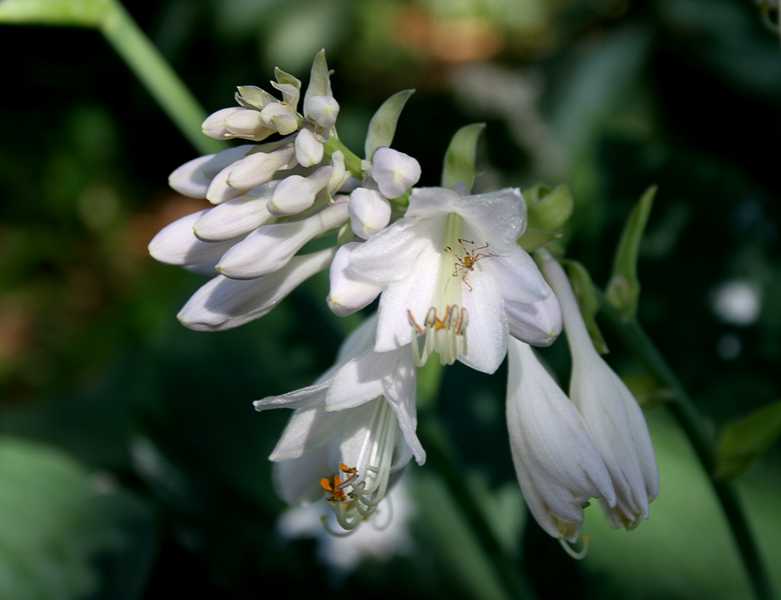 |
Hosta sieboldiana 'Elegans'
hosta
Herbaceous perennial
This is another grouping of plants that are considered reliable and hardy in central & eastern Oklahoma gardens. And again, I am mentioning a plant for specific reasons. First, because slugs are very damaging to Hostas in our area….I will offer an interesting and little heard of suggestion. You know those spiny Sweetgum balls you hate to step on in the lawn? Well, gather them and place them in a circular mound around the crown and under the leaves of Hostas. This spiny barrier will effectively deter the vast majority of slugs. Second reason for mentioning Hostas: around here the variegated Hostas and those with golden foliage are much more likely to suffer from sunburned & slug-damaged leaves than the green & blue-leafed cultivars. Of the blues, I will strongly recommend: ‘Blue Cadet’, ‘Blue Danube’, ‘Blue Wedgwood’, ‘Dorset Blue’, ‘Halcyon’, ‘Blue Umbrellas’, ‘Krossa Regal’ and Hosta sieboldiana ‘Elegans.’ One of the finest green leaved Hostas is Hosta plantaginea var. japonica. I’m recommending it for the pure white color, size and fragrance of its blooms. Oh yes, I linked to Hosta sieboldiana ‘Elegans’ because it is a bold plant with large blue grey leaves and prominent white blooms set down within the foliage. It is a favorite for slug resistance as well. |
 |
Iris 'Beverly Sills'
tall bearded iris
Herbaceous perennial
In one respect, I’m only using ‘Beverly Sills’ as a steppingstone to talking about Bearded Iris in general. These are clear mainstays in Oklahoma gardens. They create nicely clumped plantings in the middles or fronts of borders. Their bold vertical strap leaves provide good counterpoint to the foliage around them. And the blooms are stately, generously sized and beautifully colored. I also tagged these notes to ‘Beverly Sills’ because it is a strikingly beautiful, clear pink example of bearded iris at its best. One of our countries best respected Iris hybridizers used to grow and sell his plants here. He has since relocated to Oregon….but his many forms of Bearded Iris live on in many gardens. Dividing clumps every 2-4 years will best insure vigorous rhizomes and blooms. |
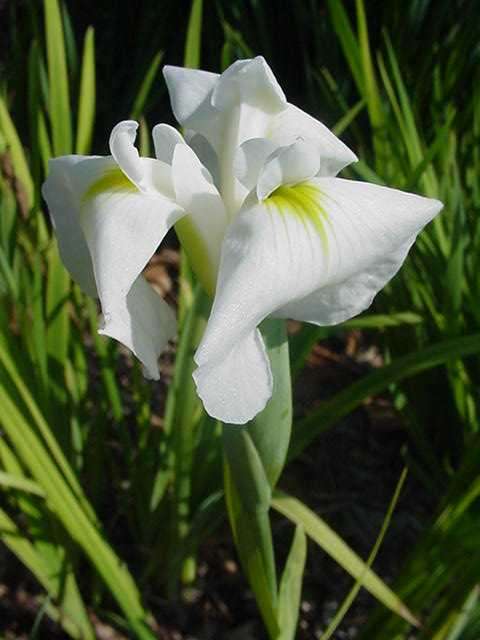 |
Iris 'Fourfold White'
Siberian iris
Herbaceous perennial
PlantFinder notes on this species and its cultivars suggest they can be grown in dry & poor soils. Oklahoma gardeners would be well advised to ignore this tolerance… and amend the soil vigorously with plenty of organic matter. These Iris will perform much better for us in well amended soils…and reward us with a much more generous bloom display. I would also suggest light shade on summer afternoons between noon and 4pm. As you can see, there are plenty of cultivars…and most will do well here. I linked to ‘Fourfold White’ because white blooms show up so nicely at night, while the more common purple colors fade into the gloom. Local sources are usually limited to 3-5 varieties, but many more can be found on-line. Siberian Iris are very beautiful… and our gardens, borders & cut-flower arrangements would be enriched enormously by planting a few of them. |
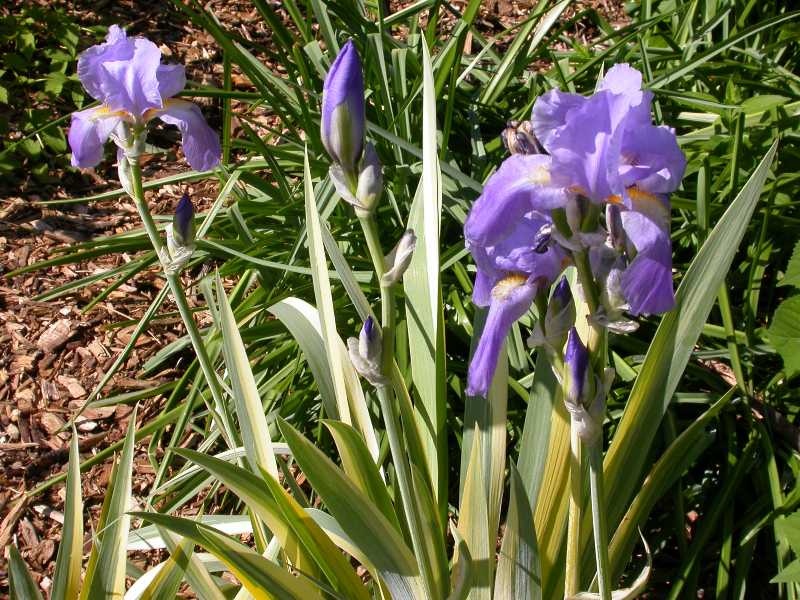 |
Iris pallida variegata
tall bearded iris
Herbaceous perennial
This iris is just as pretty out of bloom as it is when flowers are present. The variegation on the leaves lets it stand out prominently in borders of predominantly green foliage. Plant this iris in well-drained, rich, organic soil. Provide supplemental water in periods of high heat. Good sunlight is needed for good bloom. |
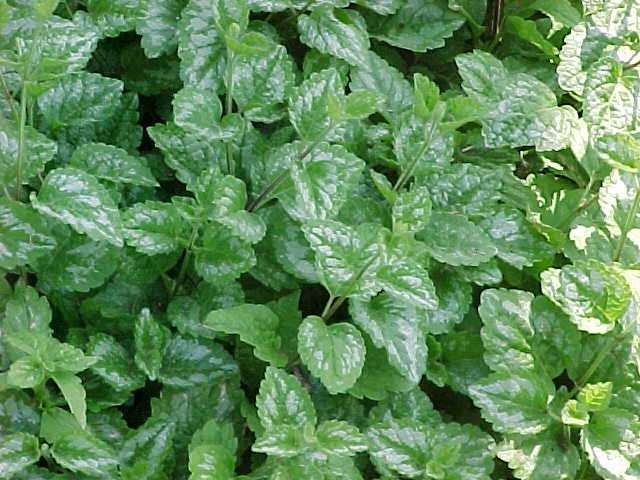 |
Lamium galeobdolon subsp. montanum 'Florentinum'
yellow archangel
Herbaceous perennial
This is a terrific groundcover for dry shade… if you don’t mind a plant that vigorously spreads once established. Both foliage & bloom are highly attractive. This is a great companion plant for large hostas. Follow PlantFinder cultural guidelines in our area as well. I would not suggest this for a mixed bed full of small and valuable perennials. It will EAT them. |
| No image |
Leucanthemum x superbum 'Polaris'
shasta daisy
Herbaceous perennial
‘Alaska’ is tall enough to require staking in Oklahoma… and even that sometimes does not protect it from flattening by our winds. ‘Snow Lady’ is so short it sometimes looks more like a mum than a Shasta Daisy. I prefer ‘Polaris’ because it’s final height [2-3 feet] is “just right” in our gardens. PlantFinder recommends deadheading to prolong the bloom season. Good idea. It also recommends dividing the clump every 2-3 years to maintain vigor. Another good idea. |
| No image |
Liatris ligulistylis 'Monarch'
button snake root
Herbaceous perennial
Gardeners need to know that this Liatris attracts Monarch Butterflies far more readily than the L. spicata ‘Kobold’ that has been so available in local nurseries. If you cannot find Liatris ligulistylis locally, try on-line. I found 7 well respected on-line nurseries within a 3 page search on Google who carry this species. Follow PlantFinder cultural notes for good success with this perennial in our gardens. |
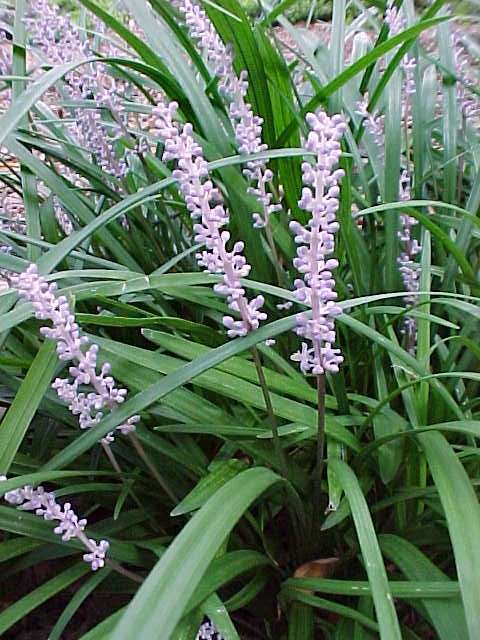 |
Liriope muscari
lily turf
Herbaceous perennial
Liriope seems to be used in our area in one of two ways. First are those who plant a row of Liriope along their front walk or as a border around the perimeter of beds. These gardeners many times end up complaining because it had spread. The second group plants Liriope as a solid groundcover under shrubs or trees. These gardeners are usually happy because their groundcover is practically evergreen, very low maintenance once established, and it blooms in late summer. NOTE: I do advise running over it with a mower on its highest setting in late winter or very early spring. This will eliminate the “thatch” of browned foliage at the base of borders or beds....and make the whole area look much better later in the summer. As PlantFinder notes, the species “spicata” spreads more aggressively than the species “muscari”. Even so, large plantings of ‘Silver Dragon’ Liriope are usually very beautiful. |
 |
Lobelia siphilitica
blue cardinal flower
Herbaceous perennial
You can succeed very well with this perennial in our area. Make sure you give it a well amended soil with plenty of compost. And provide noon to four p.m. shade in summer. Provide supplemental water during periods of high heat. Staking in our high winds is almost always advantageous. Better yet, simply locate it in the north and east beds around your home. The benefits outweigh the work….these are beautiful flowers. |
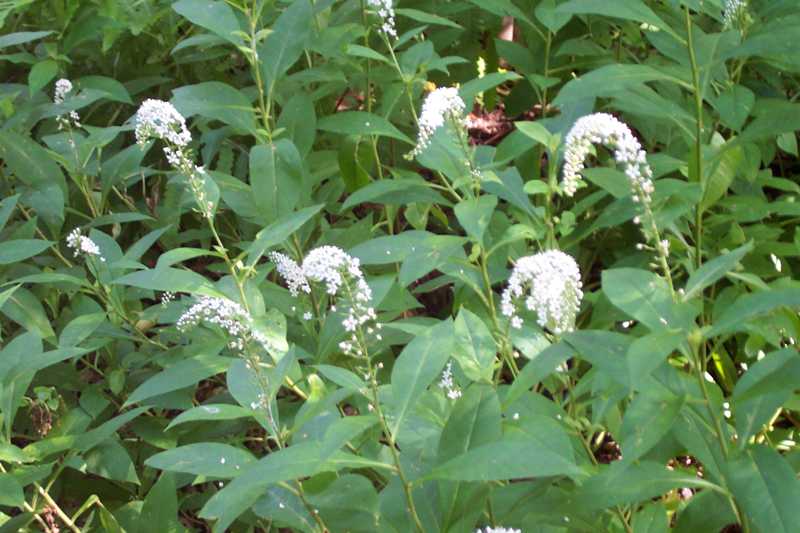 |
Lysimachia clethroides
gooseneck loosestrife
Herbaceous perennial
This is a terrific, and rarely planted perennial for our gardens. Individual stems rise from underground rhizomes. They are clothed in good, apple green leaves. In spring to early summer each stem carries a great looking bloom spike [raceme, to be horticulturally correct.] The raceme arches up and over, then up again….. creating a relaxed horizontal “S” shape. Each raceme is covered with very small, creamy white blooms. This perennial will spread rapidly if planted in moist to wet sunny sites. Less invasiveness is common in drier soils and/or light shade. Don’t let their spreading habit stop you from enjoying them. The spread can be controlled without too much effort…..and the bloom display guarantees you will like this graceful and beautiful plant. |
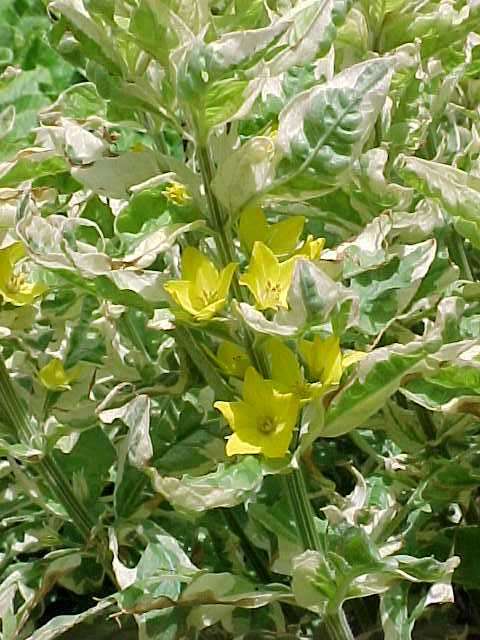 |
Lysimachia punctata 'Alexander'
loosestrife
Herbaceous perennial
A thoroughly beautiful perennial. Creamy yellow margins accentuate the green foliage and the bright yellow blooms are large enough to be easily viewed from a distance. The Myriad’s Meinder’s Garden used to contain an enormous & eye-catching specimen…but it spread too enthusiastically and was removed. So be warned…you might feel compelled to occasionally control the spread of this perennial… but that should not stop you from planting, and enjoying, this delightful plant. After all, in some Oklahoma gardens, a spreading “invasive” plant would simply fill up a lot of otherwise bare ground. |
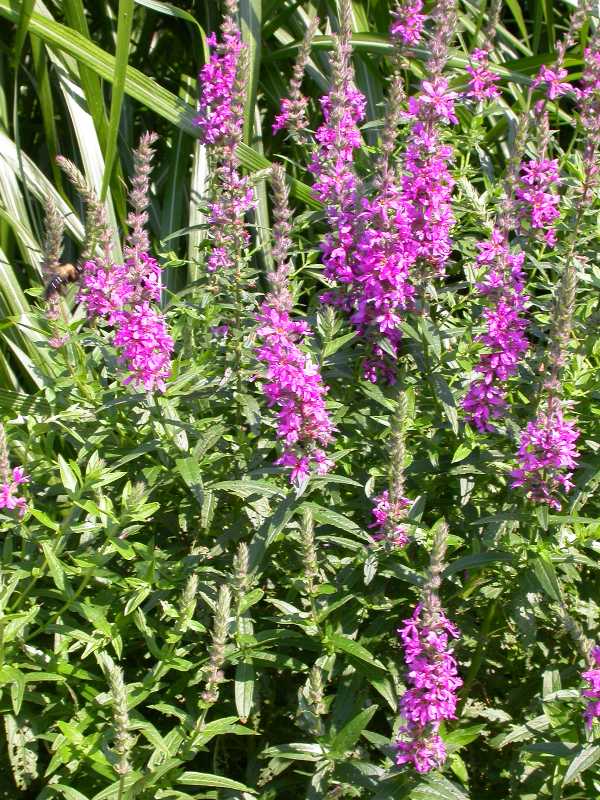 |
Lythrum salicaria
purple loosestrife
Herbaceous perennial
Back in the days when perennials were still a novelty to be experimented with; I planted two loosestrifes in my parents garden. In a sunny, moisture retentive part of the beds. By the 3rd summer we were seeing 6 x 6 foot plants, with non-stop bloom spikes from early summer ‘til fall. There are now more compact varieties… so don’t let the size comment deter you from trying this exceptional perennial. They are also, conveniently, not illegal to plant here. Oklahoma conditions have so far controlled it’s invasive qualities. [At this point, I do recommend removing bloom spikes before seed matures and disperses.] Let’s see… this is a dominant, impressive plant in bloom. Sunny sites with heavier soils are ideal planting locations. Cut it back to the ground early every spring for a lush new stand of stems and foliage and bloom. Your biggest difficulty will be choosing companion plants that are flattered by Lythrum’s bold magenta blooms. [Pale blues and yellows work very well. Whites are an understandable given. Clear pinks really glow next to Loosestrife. Deep purples create a dignified grouping.] It looks great with annual ‘Purple Fountain’ grass and the newer ‘Blackie’ potato vines. |
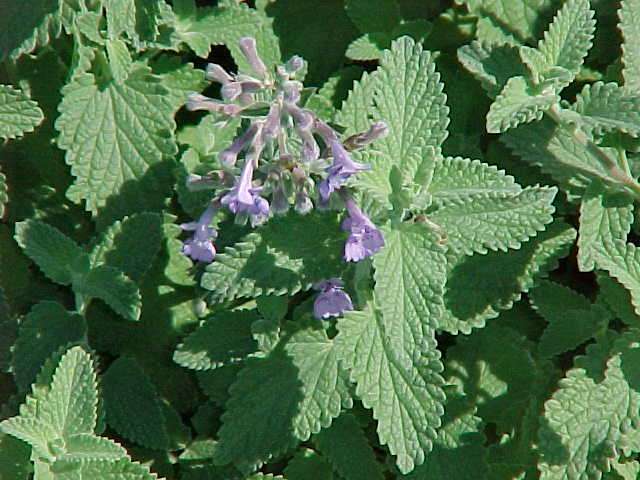 |
Nepeta x faassenii
nepeta
Herbaceous perennial
I was introduced to Faassen’s Catmint through English gardening books that told of its use at the base of roses. They were right; it not only looks great… it shades the soil… its gray green foliage contrasts beautifully with rose foliage… and its bloom color compliments the color of any rose. After initial blooms begin to fade, cut it back somewhat for another bloom display in late summer and fall. ‘Six Hills Giant’ is an excellent taller cultivar….reaching 2 feet. ‘Walker’s Low’ is a compact form that stays shorter than ‘Faassen’s.’ IMPORTANT NOTE: Nepeta mussinii is a poor substitute for any of the 3 cultivars mentioned here. The foliage is not as attractive, and it does not repeat bloom nearly as well. |
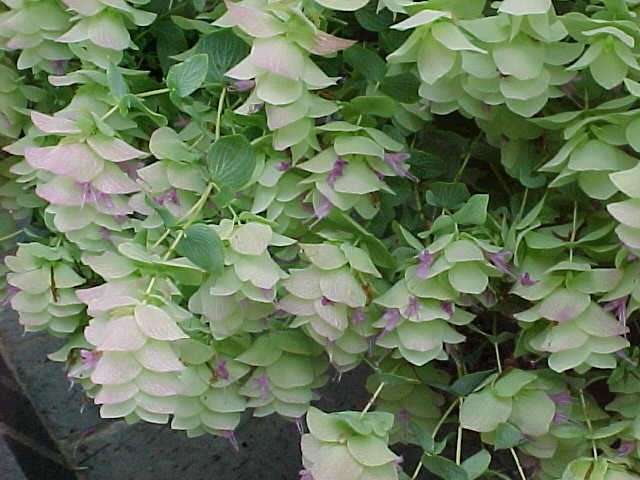 |
Origanum 'Kent Beauty'
marjoram
Herbaceous perennial
If you have a sharply well-drained site in full sun, you’ll want to find some ‘Kent Beauty’ Oregano to plant there. PlantFinder sums up the best reason when they say “Unique, drooping, pink-bracted, hop-like flowers bloom in whorls from summer to fall.” They are very beautiful, and you’ll enjoy having them hang around in your garden. |
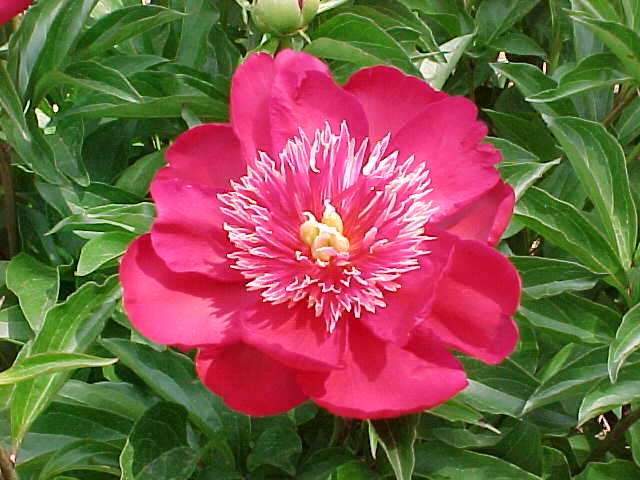 |
Paeonia lactiflora 'Charles Burgess'
peony
Herbaceous perennial
The herbaceous peony is a true garden “aristocrat” – that could easily find a place in almost any Oklahoma garden. Here is just one cultivar but many perform very well. There are simply not enough superlatives to adequately describe the beauty of a peony in full bloom. Cultural notes specific to Oklahoma gardeners emphasize [1] the need for well-drained soils [2] the need for soils generously amended with organic materials [3] the need for staking in our strong winds….[”peony cages” are available at local nurseries]… [4] a recommendation for light summer afternoon shade and [5] the occasional need for fungicidal sprays to avoid disease problems. Given respect for its cultural needs, gardeners could not ask for a more sumptuous garden flower. I know of peonies in a local ‘National Registry’ home garden that have been growing there continuously since 1903. An aesthetic note: our sun’s rays are strong and penetrating by the time Peonies bloom, so you might want to look at the brighter and stronger bloom colors in this genus and species. Those colors will withstand the tendency of our light to wash colors out of blooms. |
 |
Penstemon digitalis 'Husker Red'
beardtongue
Herbaceous perennial
Established clumps of ‘Huskers Red’ Penstemon make a bold and dramatic statement in the middle to front of a sunny border. A buying tip: look for pots of this cultivar that already have dark red leaves. Otherwise you might be getting something else. Good soil is important, so amend the soil from the hole generously with compost before setting in the plant. Good drainage is very important around here. Wet roots, particularly in winter, will doom the plant. So water thoroughly when you do, but insure that extra water will drain well away from Penstemon roots. |
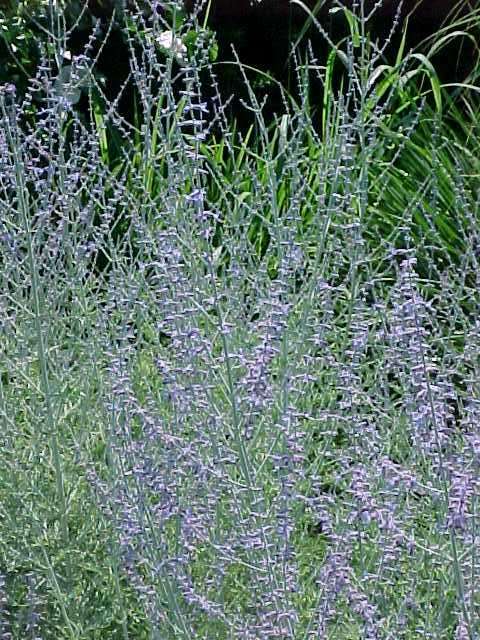 |
Perovskia atriplicifolia
Russian sage
Herbaceous perennial
Follow PlantFinder’s cultural suggestions to the letter to achieve best success with this perennial. The gray-green foliage is a nice contrast to the green of shrubs and other perennials. And the blue, slightly lavender, blooms compliment any adjacent flowers. The entire effect of finely cut foliage and muted bloom spikes is colorful, yet very subtle. |
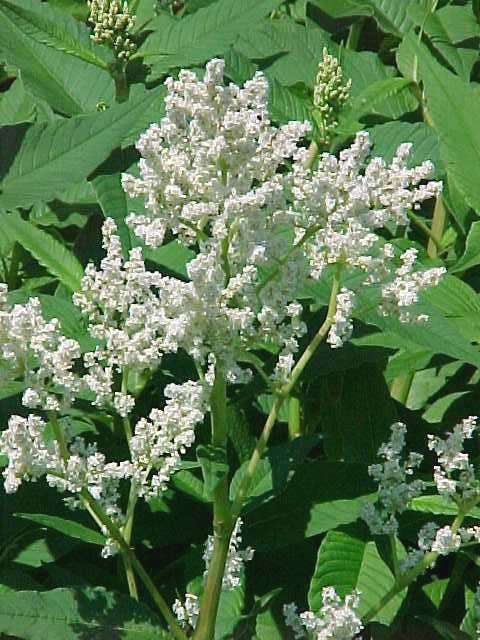 |
Persicaria polymorpha
knotweed
Herbaceous perennial
This non-invasive knotweed was first seen in the Kemper Center borders. It was beautiful…..arching stems covered with shiny green leaves and plumes of ivory white blooms. Give it a well amended, well-draining soil and a little summer afternoon shade. The sizes described by PlantFinder are very easily reached here, so locate it toward the middle or back of your border. |
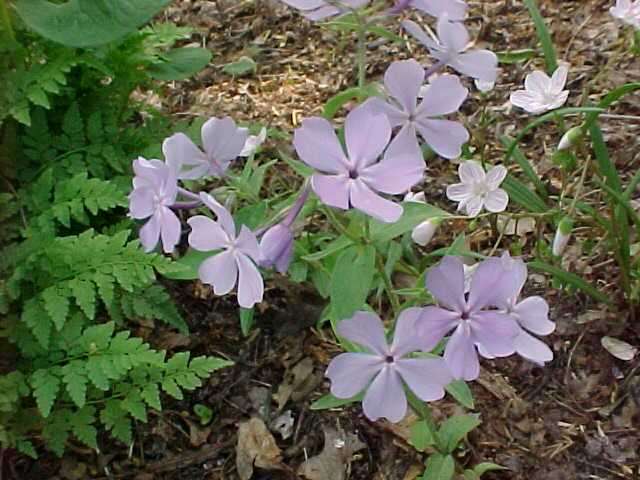 |
Phlox divaricata
wild sweet William
Herbaceous perennial
This phlox, unlike the one we are most accustomed to, grows and blooms well in moist shade. You won’t want to let this one dry out between waterings. You won’t find a much more appealing picture than a drift of this phlox & lots of spring bulbs blooming under your favorite shade tree. The color of the phlox bloom compliments any bulb bloom colors you plant nearby. |
 |
Phlox paniculata 'Mount Fuji'
garden phlox
Herbaceous perennial
This cultivar of tall phlox, and the many other cultivars, will perform best if all of the cultural recommendations offered on PlantFinder are carefully adhered to by Oklahoma gardeners. Given these conditions, the tall phlox make a striking contribution to our summer gardens. You’ll know how hardy they are when you see them blooming at old abandoned farmsteads around central Oklahoma. |
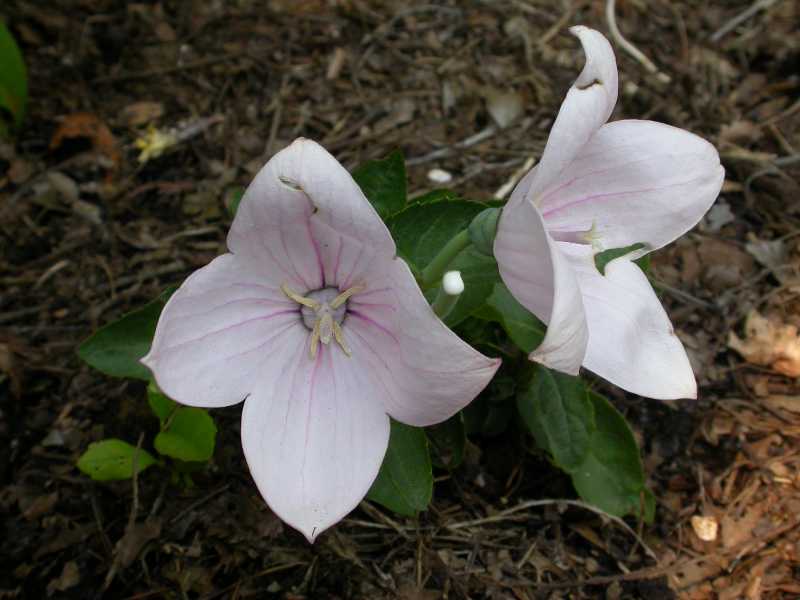 |
Platycodon grandiflorus 'Astra Pink'
balloon flower
Herbaceous perennial
I thoroughly enjoy all of the balloon flowers in any garden. The buds that look like little hot-air balloons are just as interesting as the opened blooms are beautiful. And the blooms are large enough to be appreciated from a reasonable distance. ‘Astra Pink’ is a wonderfully clear pink version of this terrific perennial. Follow PlantFinder cultural guidelines for best results in our area. |
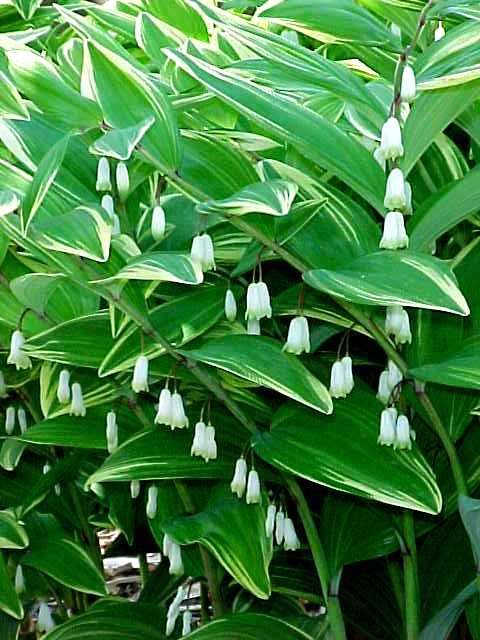 |
Polygonatum odoratum var. pluriflorum 'Variegatum'
Solomon's seal
Herbaceous perennial
This perennial is a real showstopper for gardeners with moist to wet well-drained soils in partial to full shade. It spreads, but at an easily controllable rate. At the same time, it looks good intermingling with the perennials around it. The blooms are very “subtle” and deserve to be appreciated close-up. Plant them near an entry or patio if you can. |
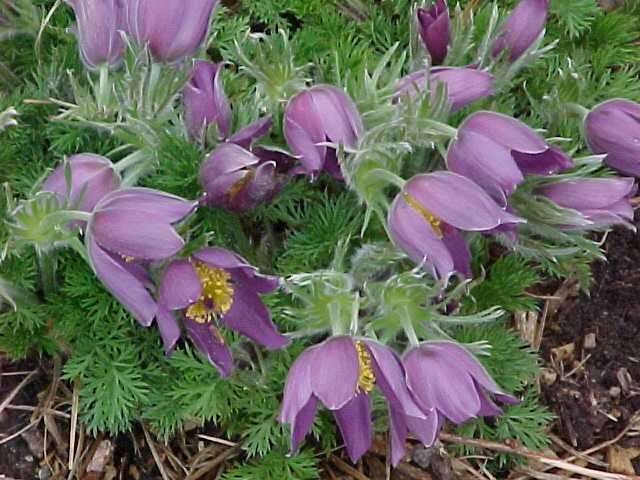 |
Pulsatilla vulgaris
pasque flower
Herbaceous perennial
Pasque flower is as elegant as it is beautiful. The frayed silky look of the buds, leaves, and stems is the first sight that will draw your attention. But the combination of regal purple blooms and grayish foliage should stop you dead in your tracks. Well-drained yet moist soil and a little light shade are essential to its success here. |
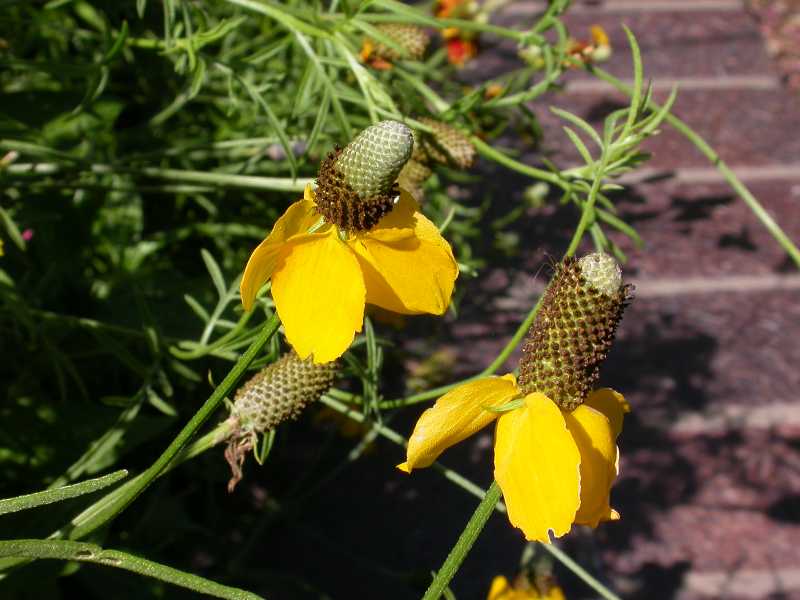 |
Ratibida columnifera
Mexican hat plant
Herbaceous perennial
I would think this would be an essential plant for any xeriscape garden. It throws a great profusion of small, unique, highly ornamental blooms. Its membership in the aster family guarantees a somewhat unkempt & languid look as a whole. But planted among other wildflowers, it mixes and mingles in a very complimentary way. Follow PlantFinder recommendations for success with this wildflower. And don’t coddle it. |
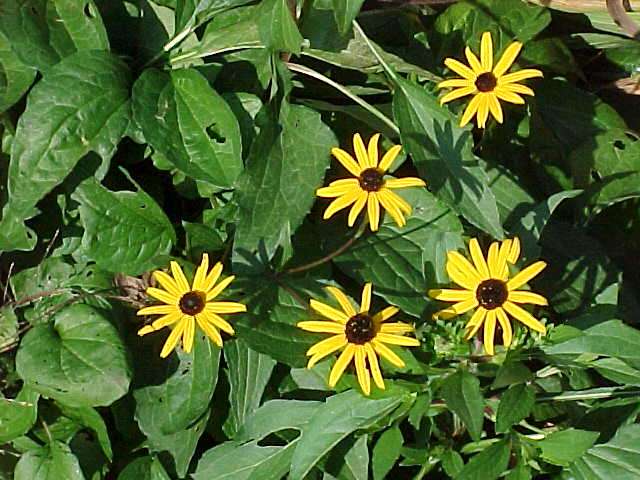 |
Rudbeckia fulgida var. sullivantii 'Goldsturm'
black-eyed Susan
Herbaceous perennial
Black eyed Susan’s are one of the backbones of late summer perennial borders. They prefer full sun, but will bloom in light shade. They spread, but are easily controlled, They are occasionally damaged by leaf-eaters, but this doesn’t really detract from their good-looks in bloom and out. They are perfectly adapted to our hot sunny borders. This particular cultivar is compact, and won’t need staking. |
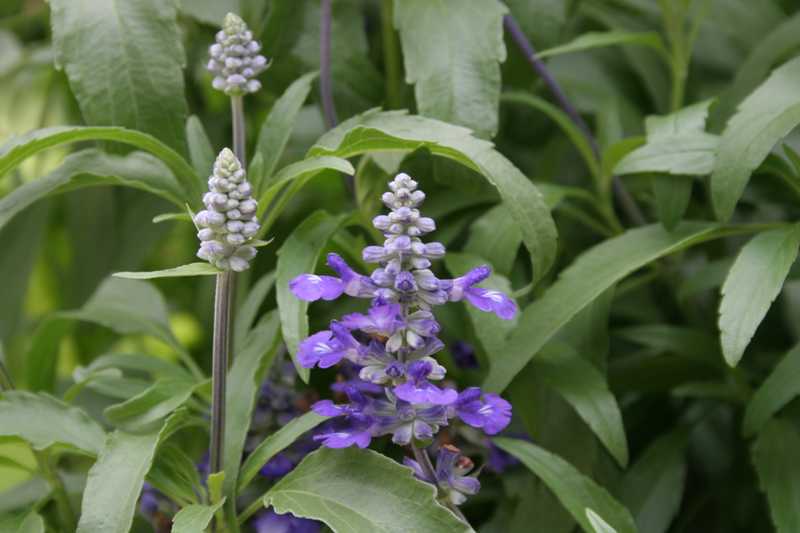 |
Salvia farinacea 'Victoria Blue'
mealycup sage
Herbaceous perennial
I won’t deny the appeal of this non-stop blooming Salvia. But I mention it here because many nurseries sell it as a perennial… and it is not reliably hardy here. I know of one nursery that sold literally hundreds of them one season…. Then sold hundreds more to the same customers the following year. By all means use it in pots or beds for great color….but do not count on it returning the following year. There are other, much better Salvia’s available that make investing much in this one rather costly and frivolous. |
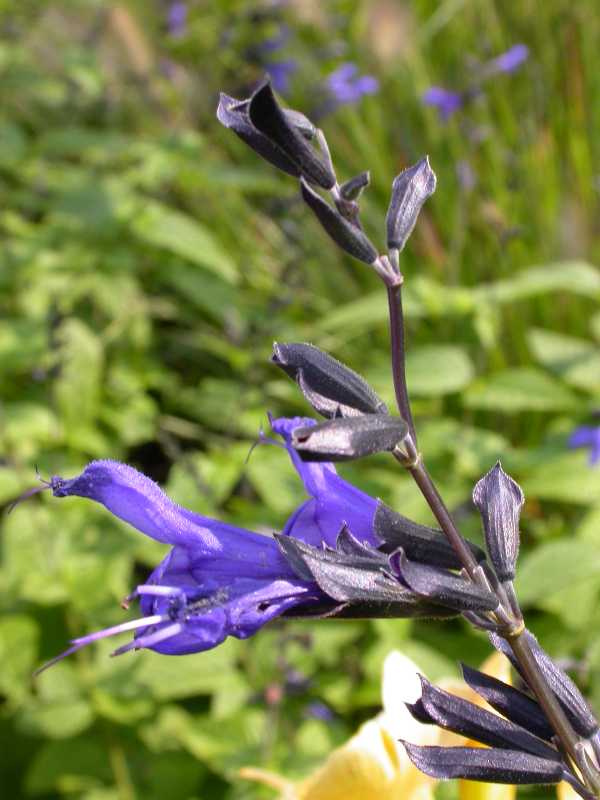 |
Salvia guaranitica
anise-scented sage
Herbaceous perennial
‘Black and Blue’ is an exceptionally beautiful cultivar of anise sage for our gardens. The brilliant blue blooms emerge from smoky black calyxes on black stems. The foliage is bright medium green. The three colors make a combination that is striking and rarely seen in the plant world. I suggest a site close to patio or front entry, because the blooms are not large….and will best be appreciated when you are close to the plant. Mulch heavily in the winter….this is a decidedly tender perennial. Better yet, plant it on the south side of your home in a richly organic sunny bed. Mine has returned for the past two seasons…. But I will gladly purchase new plants if they don’t come back in 2007. Their beauty is worth it… and so is my garden. |
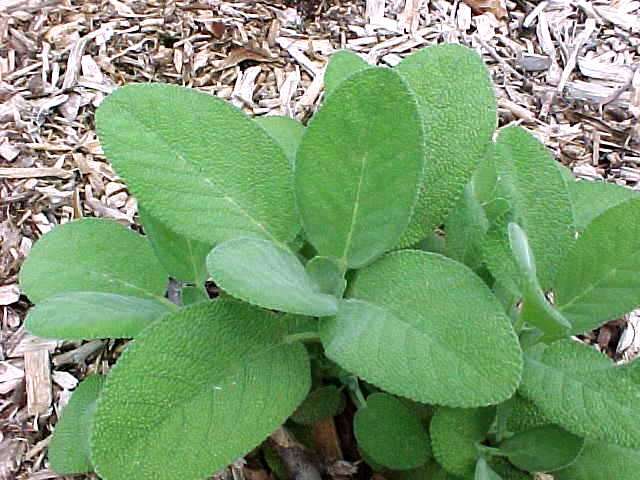 |
Salvia officinalis 'Berggarten'
common sage
Herbaceous perennial
In my humble opinion, this is a superior sage for use in the kitchen. The flavor is terrific. The leaves make a distinctly silver mound in the garden. Give it full sun and well-drained soils. Ideally, it belongs in a hot, dry corner of your garden that you can also dedicate to thyme’s and rosemary and oregano. To use frequently, you must be willing to pinch out flower formations as they occur, because this will insure the continued production of fresh leaves. Anyway, this one is easy to find… just make sure the tag says ‘Berggarten.’ |
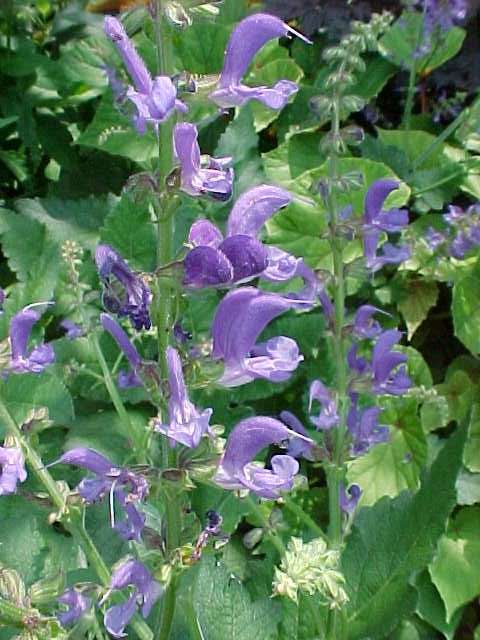 |
Salvia transsylvanica 'Blue Cloud'
sage
Herbaceous perennial
This is a terrific perennial if you have well-drained soil you’re willing to run slightly moist in summer. They are drought tolerant if necessary. The blooms are a wonderful shade of blue….and make very good cut flowers. They attract butterflies to our gardens. You may have to look for this one, but it’s reliable hardiness and good looks make the search worthwhile. |
 |
Salvia x sylvestris 'Mainacht' MAY NIGHT
wood sage
Herbaceous perennial
An excellent plant for moist sunny areas. It will tolerate drought, but don’t push your luck around here. Also plan on rigorous and consistent deadheading if you want to prolong the season of bloom. Given that, this perennial has excellent narrow dark spires of flowers. They look terrific at the base of roses. They mix well with Coneflowers and ‘Powis Castle’ Artemisia. They look great with Catmint [but avoid letting the Catmint smother the Salvia. Use generous spacing here.] |
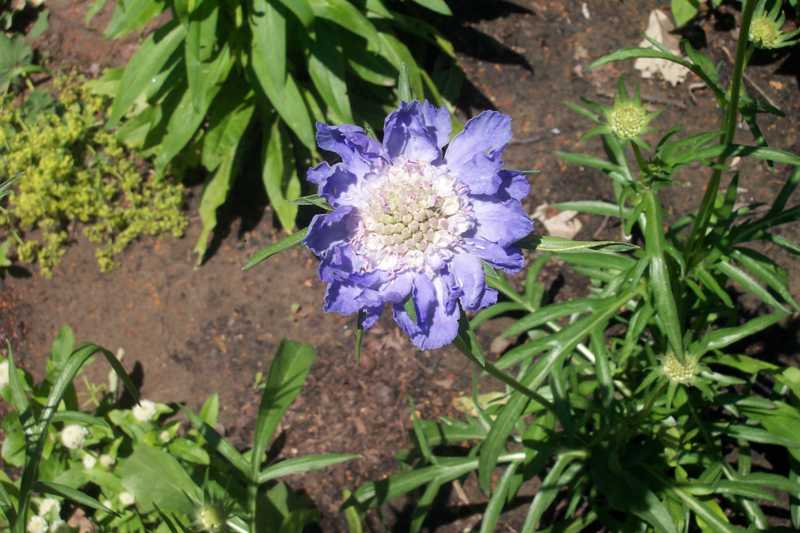 |
Scabiosa caucasica
pincushion flower
Herbaceous perennial
As PlantFinder points out, sharply well-drained soil is the key to success with this perennial. Far too many gardeners around here lose their plants because the roots stay too moist. And the key to a long bloom season is regular deadheading [the removal of spent blooms before seed production starts.] Full sun is strongly recommended. Shade will affect moisture retention in the soil, and this should be avoided. |
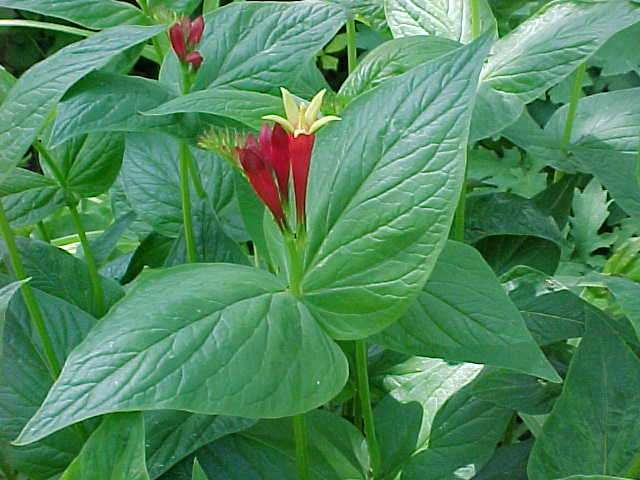 |
Spigelia marilandica
Indian pink
Herbaceous perennial
This easily grown perennial is seldom seen in Oklahoma gardens. More’s the pity, because it very reliably grows and blooms in anything from light to deep shade. Let me repeat that last attribute… This perennial will reliably bloom in deep shade. That quality alone makes it well worth considering for many of our finer and older gardens. Because our soils tend toward heavy clay….it is advisable to amend the planting site with plenty of organic material. Bloom here will normally occur in early to mid May. This is a great, and tragically under-used, Oklahoma native. The Oklahoma City Zoo knows…. They have a terrific colony of these perennials just north of the Harpy Eagle exhibit…. in some deep shade. |
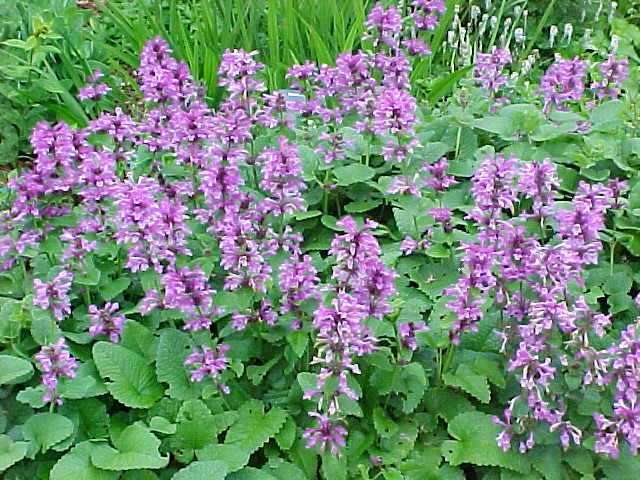 |
Stachys macrantha 'Superba'
big betony
Herbaceous perennial
This is another perennial I first saw and learned about at the Kemper Center in the Missouri Botanical Garden. At first sight, I momentarily thought “That’s the biggest Ajuga I’ve ever seen!” I also thought for a second I was seeing a “Hyacinth Shrub.” Don’t ask… the point is…. Big Betony is a very attractive perennial… with tall spikes of large tubular flowers that really stand out well in the garden. Pay close attention to PlantFinder cultural notes for best success. [Light afternoon shade is strongly recommended here.] This is not, unfortunately, an easy perennial to find on the market. But keep looking… it is decidedly worth it. |
 |
Stokesia laevis
Stokes' aster
Herbaceous perennial
Most of the growing season, I almost forget this plant lives in my borders. It’s leaves form a low rosette that is fairly unassuming. But once a year, usually in June, they put out stems topped with elegant flowers. The blooms are large, very frilly, somewhat like cornflowers but more delicate, many times in shades of blue….sometimes in pink….and very rarely pale yellow. Then, for awhile, I can scarcely talk about any other blooms. Nicer still, they have a fairly generous bloom season…. Especially if deadheaded. We are fortunate enough to have blues and yellows. But any of the cultivars listed on PlantFinder will do equally well here. Be attentive to PlantFinder cultural notes and recommendations. |
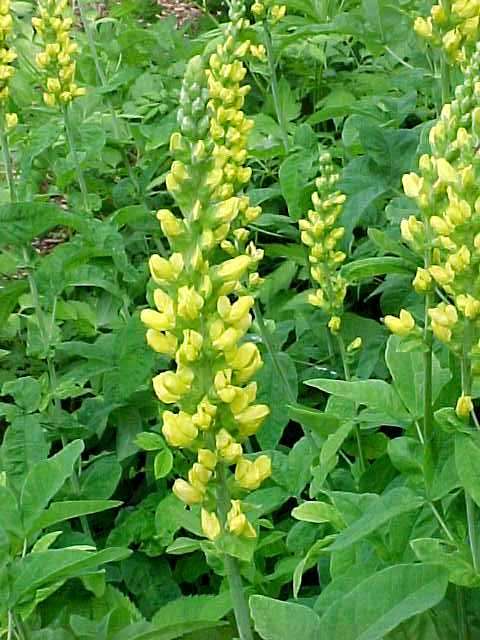 |
Thermopsis villosa
Carolina lupine
Herbaceous perennial
I would almost suggest you plant this perennial in situ from seed…. rather than plants. Unless you can assure yourself the container plant has a healthy root system without intertwined taproots. Either way, this is the closest you will come to imitating Russell Lupines out here on the southern great plains. This is an easy perennial once established. It likes our heat and humidity. Full sun & well-drained soils only. |
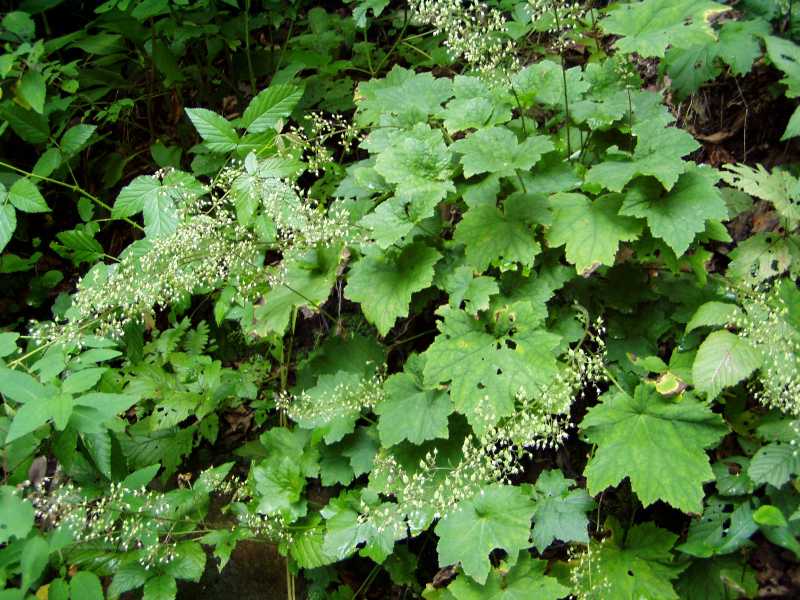 |
Tiarella cordifolia
foam flower
Herbaceous perennial
The foliage of foamflower cultivars is small enough to contrast nicely with Hostas and Hellebores… and large enough to be prominent and attractive. The vertical spikes of flowers are delicate enough to look, en masse, like foam spread across the garden. Plant in light to medium shade, in well amended & well draining soil. Maintain moisture in the soil during periods of high heat. Do not let the roots become waterlogged in winter. |
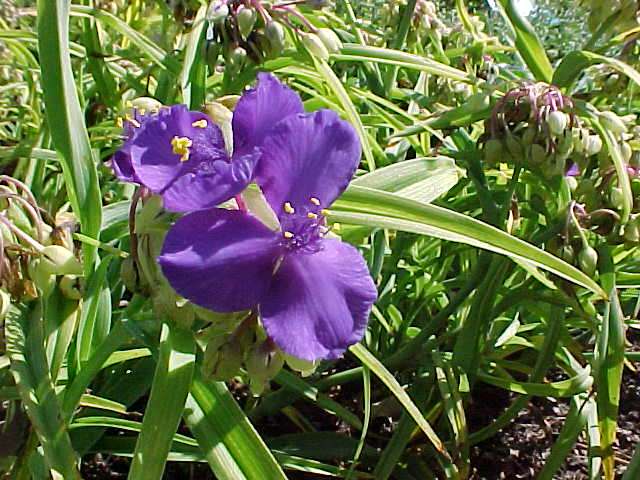 |
Tradescantia (Andersoniana Group) 'Sweet Kate'
spiderwort
Herbaceous perennial
Although PlantFinder recommends full sun for best foliage color in Missouri….I suggest light afternoon shade for Oklahoma gardens. By that I mean shade from noon until about 4pm. I’m not normally enthusiastic about the Spiderworts [my apologies to devotees]… but this one is well worth having in your afternoon shade garden. The foliage is chartreuse gold and the blooms are deep purple blue. The contrast is striking…. And, strangely, complimentary at the same time. This perennial needs well amended soils and supplemental summer water. The reward is a generous splash of gold and blue in the middle of your otherwise green shady borders. |
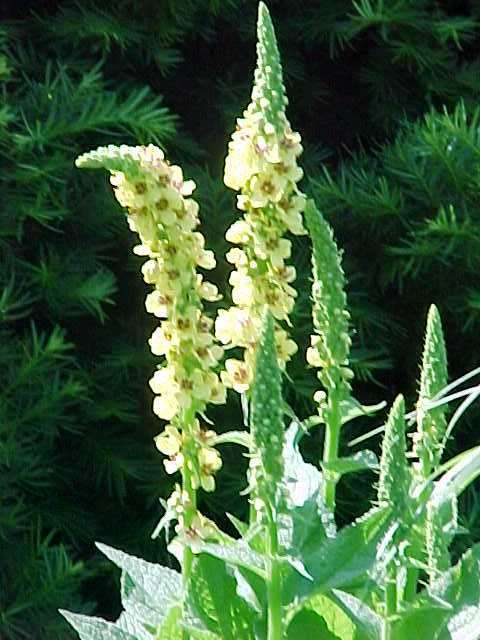 |
Verbascum chaixii
nettle-leaved mullein
Herbaceous perennial
This is a bold, architecturally striking plant for dry, sunny borders. Very lean & well-drained soil is essential to it’s continued success. Give it that, and full sun….and you will enjoy strong stems topped with racemes of bold blooms well into the summer season. PlantFinder’s reference to a short life-span should encourage you to allow the seedheads to remain and mature on the plant. Gently dispersing mature seed will insure this plants return year after year. ‘Album’, ‘Helen Johnson’, and ‘Southern Charm’ are hybrids well worth looking for in local nurseries and on-line. Last year, local nurseries had good selections of this previously hard-to-find plant. |
 |
Veronica 'Sunny Border Blue'
speedwell
Herbaceous perennial
This is a beautiful perennial for the front of the mixed border. The foliage has enough gloss to be very attractive, and the spikes of bloom are an excellent color of blue. Well-drained moist soil in full sun is the best location. Deadhead regularly to prolong the bloom season. |
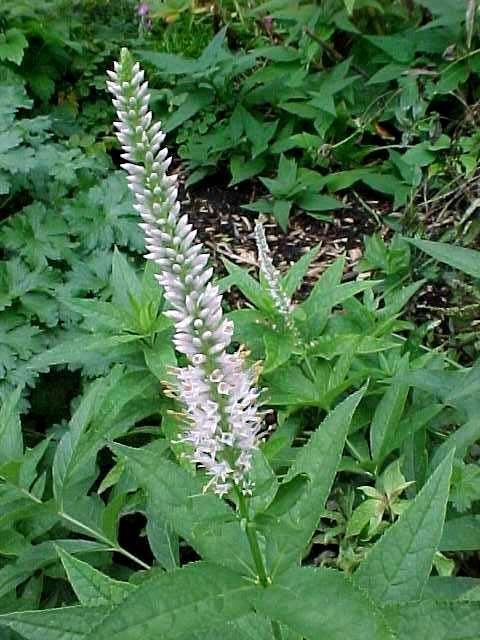 |
Veronicastrum virginicum 'Album'
Culver's root
Herbaceous perennial
This wonderful perennial is almost unknown in area gardens. That is unfortunate….because it is easy to grow and very beautiful in bloom. The spikes of pure white blooms are almost impossibly slender, and last well into summer. The only reason for its scarcity around here might be the length of time it takes to get a large plant. That reason should be nullified by its amenability to our clay soils. Just plant it in a moist to wet sunny spot and forget it for a few years until it establishes itself. I did, and after 4 years, began getting a large and stately plant this past summer. Because it deserves to be easily seen, I would plant it near patios or entries. |
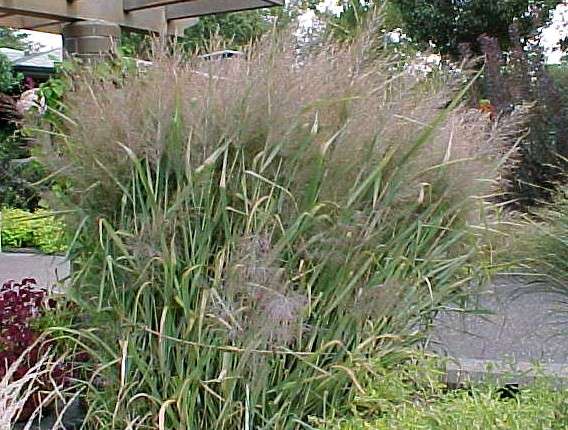 |
Panicum virgatum 'Dallas Blues'
switch grass
Ornamental grass
The ornamental grasses are normally in a class by themselves. Since this is my only planned entry in grasses, I’ll put it here. I’m linking to ‘Dallas Blues’ Switchgrass for two reasons. First, it is a beautiful and prominent garden plant. The foliage has enough blue coloration to please any lover of blue foliage. The flower panicles are large, intricate, and elegant. They have more substance than Maiden Grass panicles and less sheer bulk than the blooms of Pampas Grass. The fall and winter foliage is, to me, it’s most pleasant aspect. The colors are tawny, leonine golds and burnished blues….. it makes a subtle and striking composition. My second reason for linking to this grass…. Oklahoma City gardeners have locked into one variety of a trendy plant…. and planted little else. ‘Maiden’ Grass is omnipresent here….. and getting as boringly redundant as row cropping. ‘Dallas Blues’ is just one terrific alternative you should consider for your garden. |
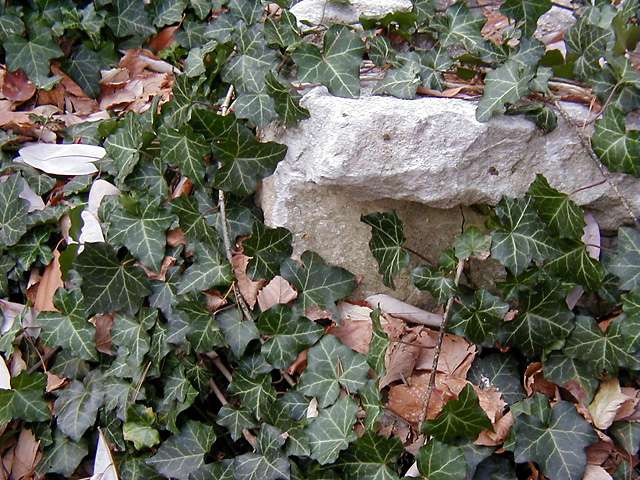 |
Hedera helix var. baltica
English ivy
Vine
I almost passed on mentioning English Ivy. But then I remembered the beautiful plantings I have seen here and in Dallas. They frequently cover the entire front yard…virtually replacing lawn grass. And they look particularly good in winter when the large deciduous trees they are planted under are mere silhouettes, growing out of a dark glossy green carpet of living leaves. Two cautions: one concerns letting it grow up structures. When it does, it will root into the surface of the wall… eventually causing damage. Second, allowing English Ivy to climb the trunks and branches of a mature & venerable tree is doing the tree a disservice. Again, the roots will spread by growing into the tree…robbing energy from the tree and eventually causing problems. So think twice before letting it climb… ANYTHING. Allow it, however, to spread in ground level shade wherever it cares to go. This is a beautiful plant if handled with respect for it’s needs and an awareness of its shortcomings. |